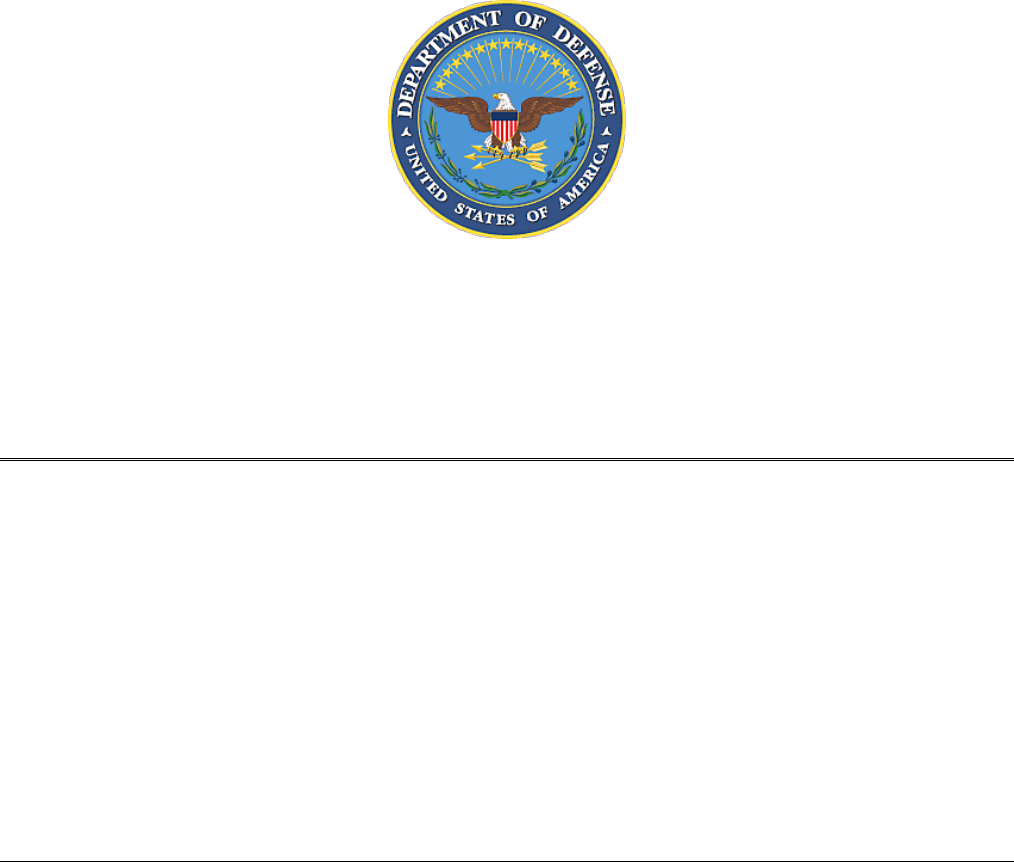
DOD MANUAL 5110.04, VOLUME 1
M
ANUAL FOR WRITTEN MATERIAL:
C
ORRESPONDENCE MANAGEMENT
Originating Component: Office of the Chief Management Officer of the Department of Defense
Effective: June 16, 2020
Releasability: Cleared for public release. Available on the Directives Division Website
at https://www.esd.whs.mil/DD/.
Reissues and Cancels: DoD Manual 5110.04-M, Volume 1, “DoD Manual for Written Material:
Correspondence Management,” October 26, 2010, as amended
Approved by: Lisa W. Hershman, Chief Management Officer of the Department of
Defense
Purpose: This manual is composed of two volumes, each containing its own purpose. In accordance
with the authority in DoD Directive 5105.82, the July 11, 2014 Deputy Secretary of Defense
(DepSecDef) Memorandum, the February 1, 2018 Secretary of Defense (SecDef) Memorandum, and the
policy in DoD Instruction (DoDI) 5025.13:
• This manual provides guidance for managing:
o The correspondence of the SecDef, the DepSecDef, and the Executive Secretary of the DoD
(ExecSec).
o The correspondence of the OSD and DoD Components that is directed to the SecDef, the
DepSecDef, and the ExecSec.
• This volume:
o Assigns responsibilities and provides procedures for preparing and submitting correspondence to
SecDef, DepSecDef, and ExecSec using appropriate formatting, grammar, and writing guidelines in
accordance with DoDI 5025.13.
o Establishes the Director, Executive Services Directorate (ESD), under the authority, direction,
and control of the Director, Washington Headquarters Services (WHS) as the lead agent for processing,
controlling, disseminating, and archiving official classified and unclassified correspondence addressed
to and sent by the SecDef, the DepSecDef, and the ExecSec.
DoDM 5110.04, Volume 1, June 16, 2020
TABLE OF CONTENTS 2
TABLE OF CONTENTS
SECTION 1: GENERAL ISSUANCE INFORMATION .............................................................................. 7
1.1. Applicability. .................................................................................................................... 7
1.2. Information Collections. ................................................................................................... 7
SECTION 2: RESPONSIBILITIES ......................................................................................................... 8
2.1. Director, ESD. ................................................................................................................... 8
2.2. Assistant to the Secretary of Defense for Public Affairs (ATSD(PA)). ........................... 8
2.3 Assistant Secretary of Defense for Legislative Affairs (ASD(LA)). ................................. 8
2.4. General Counsel of the Department of Defense (GC DoD). ............................................ 9
2.5. OSD and DoD Component Heads. ................................................................................... 9
SECTION 3: GENERAL CORRESPONDENCE MANAGEMENT ............................................................. 10
3.1. Assigning Action on SecDef, DepSecDef, and ExecSec Correspondence. .................... 10
3.2. Assigning Suspense Dates. ............................................................................................. 10
3.3. Routing Incoming Correspondence. ............................................................................... 11
3.4. Processing OSD and DoD Component Actions.............................................................. 12
3.5. Providing Status or Requesting Changes to Actions. ..................................................... 12
a. Use of SD Form 391, “Secretary of Defense Correspondence Action Report.” .......... 12
b. Changes to Action Assignments. ................................................................................. 13
3.6. Coordinating Assigned Actions. ..................................................................................... 14
3.7. Submitting Materials to the SecDef, the DepSecDef, or the ExecSec. ........................... 15
3.8. Suspense Reporting. ........................................................................................................ 16
SECTION 4: WHITE HOUSE CORRESPONDENCE MANAGEMENT ..................................................... 17
4.1. General Processing Information. .................................................................................... 17
4.2. Assigning Suspense Dates for White House Correspondence. ....................................... 17
4.3. Replying to White House Correspondence. .................................................................... 18
a. Draft Reply. .................................................................................................................. 18
b. Interim Reply. .............................................................................................................. 18
c. Final Reply. .................................................................................................................. 19
4.4. Preparing DoD-Originated White House Correspondence. ............................................ 19
4.5. Forms of Address. ........................................................................................................... 19
SECTION 5: CONGRESSIONAL CORRESPONDENCE MANAGEMENT ................................................. 21
5.1. CMD Procedures Reporting. ........................................................................................... 21
5.2. Signature Authorities. ..................................................................................................... 21
5.3. Offices of Primary Responsibility. ................................................................................. 21
SECTION 6: WRITING STYLE AND PREFERRED USAGE ................................................................... 24
6.1. General Guidelines.......................................................................................................... 24
a. Action and Info Memoranda. ....................................................................................... 24
b. Correspondence for Principals’ Signature. .................................................................. 24
c. References. ................................................................................................................... 24
6.2. Preparation. ..................................................................................................................... 24
a. Subject Line on Memoranda and Messages. ................................................................ 24
b. Audience. ..................................................................................................................... 25
c. Purpose. ........................................................................................................................ 25
6.3. Organization, Clarity, and Style...................................................................................... 26
DoDM 5110.04, Volume 1, June 16, 2020
TABLE OF CONTENTS 3
a. Organization. ................................................................................................................ 26
b. Clarity and Style. ......................................................................................................... 28
6.4. Capitalization, Punctuation, and Usage. ......................................................................... 31
a. Capitalization. .............................................................................................................. 31
b. Acronyms and Abbreviations. ..................................................................................... 32
c. Punctuation. .................................................................................................................. 33
d. Numbers. ...................................................................................................................... 35
e. Dates. ............................................................................................................................ 36
f. Commonly Confused Words. ....................................................................................... 36
SECTION 7: MEMORANDA ............................................................................................................. 38
7.1. When to Use a Memorandum. ........................................................................................ 38
7.2. Preparing Standard Memoranda. .................................................................................... 38
a. Stationery. .................................................................................................................... 38
b. Margins. ....................................................................................................................... 39
c. Font. ............................................................................................................................. 39
d. Spacing. ........................................................................................................................ 39
e. Indentation.................................................................................................................... 39
f. Paragraphing. ................................................................................................................ 39
g. Page Numbering........................................................................................................... 39
h. Date. ............................................................................................................................. 40
i. Address Line. ................................................................................................................ 40
j. Attention Line. .............................................................................................................. 41
k. Through Line. .............................................................................................................. 41
l. Subject Line. ................................................................................................................. 41
m. References. .................................................................................................................. 41
n. Salutation. .................................................................................................................... 42
o. Body. ............................................................................................................................ 42
p. Complimentary Close. ................................................................................................. 42
q. Signature Block. ........................................................................................................... 43
r. Attachments. ................................................................................................................. 43
s. Material Under Separate Cover. ................................................................................... 44
t. Courtesy Copies (cc). .................................................................................................... 44
u. Security Classification Markings. ................................................................................ 46
7.3. Action Memoranda. ........................................................................................................ 46
a. Preparing an Action Memorandum. ............................................................................. 46
b. Assembling an Action Memorandum Package. ........................................................... 48
c. Submitting an Action Memorandum Package. ............................................................ 49
7.4. Information (Info) Memoranda. ...................................................................................... 49
a. Preparing an Info Memorandum. ................................................................................. 49
b. Assembling an Info Memorandum Package. ............................................................... 50
c. Submitting an Info Memorandum Package.................................................................. 51
7.5. Multi-Addressee Memoranda. ........................................................................................ 51
a. Preparing a Multi-Addressee Memorandum. ............................................................... 51
b. Ordering Multi-Addressees. ......................................................................................... 51
c. Submission and Distribution of Multiple-Addressee Memoranda............................... 54
DoDM 5110.04, Volume 1, June 16, 2020
TABLE OF CONTENTS 4
SECTION 8: LETTERS ..................................................................................................................... 65
8.1. When to Use a Letter. ..................................................................................................... 65
8.2. Preparing Official Letters. .............................................................................................. 65
a. Stationery. .................................................................................................................... 65
b. Margins. ....................................................................................................................... 65
c. Font. ............................................................................................................................. 66
d. Spacing. ........................................................................................................................ 66
e. Indentation.................................................................................................................... 66
f. Paragraphing. ................................................................................................................ 66
g. Page Numbering........................................................................................................... 66
h. Date. ............................................................................................................................. 66
i. Address. ........................................................................................................................ 66
j. Attention Line. .............................................................................................................. 67
k. Salutation. .................................................................................................................... 67
l. Body. ............................................................................................................................. 67
m. Complimentary Close. ................................................................................................ 68
n. Signature Block. ........................................................................................................... 68
o. Enclosures. ................................................................................................................... 69
p. Material Under Separate Cover. .................................................................................. 70
q. Courtesy Copies. .......................................................................................................... 70
r. Security Classification Markings.................................................................................. 71
8.3. Packaging a Letter for Delivery. ..................................................................................... 71
8.4. Submitting a Letter for Signature. .................................................................................. 72
8.5. Preparing Personal Letters for SecDef and DepSecDef Signature. ................................ 72
a. Stationery and Envelopes. ............................................................................................ 72
b. Subject and Attention Lines. ........................................................................................ 72
c. Date. ............................................................................................................................. 72
d. Forms of Address. ........................................................................................................ 72
e. Envelope Address......................................................................................................... 74
f. Signature Block. ........................................................................................................... 74
g. Courtesy Copies. .......................................................................................................... 75
h. Special Handling Instructions. ..................................................................................... 75
SECTION 9: CATMS ..................................................................................................................... 77
9.1. General. ........................................................................................................................... 77
9.2. Using CATMS to Task and Coordinate Correspondence. .............................................. 77
9.3. Processing Correspondence in CATMS. ........................................................................ 77
SECTION 10: COMMUNICATIONS WITH FOREIGN GOVERNMENT OFFICIALS .................................. 79
10.1. General. ......................................................................................................................... 79
10.2. Preparing and Submitting Electronic Messages. .......................................................... 79
10.3. Processing Electronic Communications. ...................................................................... 79
SECTION 11: E-MAIL ..................................................................................................................... 80
11.1. General. ......................................................................................................................... 80
11.2. Guidelines. .................................................................................................................... 80
11.3. CMD’s Use of E-mail. .................................................................................................. 81
SECTION 12: LETTERHEAD STATIONERY ....................................................................................... 82
DoDM 5110.04, Volume 1, June 16, 2020
TABLE OF CONTENTS 5
12.1. General. ......................................................................................................................... 82
12.2. Guidance. ...................................................................................................................... 82
12.3. Authorizations. .............................................................................................................. 82
a. Authorized Users. ......................................................................................................... 82
b. Authorized Designators. .............................................................................................. 83
12.4. Procedures. .................................................................................................................... 84
a. Preprinted Official Letterhead Stationery. ................................................................... 84
b. Computer-generated Letterhead Stationery. ................................................................ 85
c. Envelopes. .................................................................................................................... 85
SECTION 13: OFFICIAL DIGRAPHS AND TRIGRAPHS ....................................................................... 86
13.1. For Component assignments. ........................................................................................ 86
13.2. For Action Required. .................................................................................................... 88
GLOSSARY ..................................................................................................................................... 89
G.1. Acronyms. ...................................................................................................................... 89
REFERENCES .................................................................................................................................. 91
TABLES
Table 1. Action Suspense Types and Timelines .......................................................................... 11
Table 2. Materials Not Processed Through CMD ....................................................................... 12
Table 3. SD Form 391 Approval Authorities ............................................................................... 14
Table 4. Addressing the President ............................................................................................... 19
Table 5. Addressing the Vice President ....................................................................................... 20
Table 6. Addressing Members of Congress ................................................................................. 23
Table 7. Examples of Vague Subjects and Suggested Alternatives ............................................. 25
Table 8. Transitional Words and Phrases .................................................................................... 27
Table 9. Examples of Passive Voice and Suggested Alternatives ................................................ 29
Table 10. Examples of Weak Verb Phrases and Suggested Alternatives .................................... 30
Table 11. Subject-Verb Agreement Guidelines ............................................................................ 31
Table 12. Examples of DoD-Specific Capitalization ................................................................... 32
Table 13. List of Commonly Confused Words ............................................................................ 37
Table 14. Sample Attention Lines in Memoranda ....................................................................... 41
Table 15. Listing References ....................................................................................................... 42
Table 16. Dual and Multiple Signature Blocks ............................................................................ 43
Table 17. Listing Attachments ..................................................................................................... 44
Table 18. Sample List of Material Under Separate Cover in a Memorandum ............................ 44
Table 19. Sample Courtesy Copy Listings in Memoranda .......................................................... 45
Table 20. Listing Coordinating Officials ..................................................................................... 49
Table 21. Sample Attention Line in a Letter................................................................................ 67
Table 22. Listing Enclosures........................................................................................................ 70
Table 23. Sample List of Material Under Separate Cover in a Letter ......................................... 70
Table 24. Sample Courtesy Copy Listings in Letters .................................................................. 71
Table 25. Addressing a Foreign Chief of State, Head of Government, or Cabinet Minister ....... 73
Table 26. Digraphs and Trigraphs for Action or Information Component Assigned .................. 86
Table 27: Digraphs and Trigraphs for Action Required .............................................................. 88
DoDM 5110.04, Volume 1, June 16, 2020
TABLE OF CONTENTS 6
FIGURES
Figure 1. Sample Standard Unclassified Memorandum .............................................................. 55
Figure 2. Sample Standard Classified Memorandum .................................................................. 57
Figure 3. Sample Action Memorandum....................................................................................... 59
Figure 4. Sample Classified Info Memorandum .......................................................................... 60
Figure 5. Sample Multi-Addressee Memorandum....................................................................... 62
Figure 6. Sample Multi-Addressee Memorandum with Combatant Commanders...................... 64
Figure 7. Sample Official Letter .................................................................................................. 76
DoDM 5110.04, Volume 1, June 16, 2020
SECTION 1: GENERAL ISSUANCE INFORMATION 7
SECTION 1: GENERAL ISSUANCE INFORMATION
1.1. APPLICABILITY.
This issuance applies to OSD, the Military Departments, the Office of the Chairman of the Joint
Chiefs of Staff and the Joint Staff, the Combatant Commands, the Office of the Inspector
General of the Department of Defense, the Defense Agencies, the DoD Field Activities, and all
other organizational entities within the DoD (referred to collectively in this issuance as the “DoD
Components”).
1.2. INFORMATION COLLECTIONS.
The Standard (SD) Form 391, “Secretary of Defense Correspondence Action Report,” (located at
https://www.esd.whs.mil/Portals/54/Documents/DD/forms/sd/sd0391.pdf) referred to in
Paragraph 3.5.a., does not require licensing with a report control symbol in accordance with
Volume 1 of DoD Manual 8910.01.
DoDM 5110.04, Volume 1, June 16, 2020
SECTION 2: RESPONSIBILITIES 8
SECTION 2: RESPONSIBILITIES
2.1. DIRECTOR, ESD.
Under the authority, direction, and control of the Director, WHS, the Director, ESD:
a. In coordination with the ExecSec, executes the correspondence management, processing,
distribution, and archival functions of SecDef, DepSecDef, and ExecSec official correspondence
in accordance with Director of Administration and Organizational Policy, Office of the Chief
Management Officer of the Department of Defense (DAOP OCMO) responsibilities for SecDef,
DepSecDef, and ExecSec correspondence and this manual.
b. Develops and distributes correspondence guidance as necessary through appropriate
channels such as memoranda, websites, amended appendixes or administrative updates to this
volume, or other communications with OSD and DoD Component correspondence management
offices (CCMOs) as appropriate.
c. Oversees Correspondence and Task Management System (CATMS) administration for
managing the official correspondence of the SecDef and the DepSecDef in accordance with
DoDI 5045.01.
2.2. ASSISTANT TO THE SECRETARY OF DEFENSE FOR PUBLIC AFFAIRS
(ATSD(PA)).
In addition to the responsibilities in Paragraph 2.5., the ATSD(PA) coordinates on all
correspondence that:
a. Contains information with public affairs implications.
b. Involves requests for SecDef or DepSecDef participation in public forums, such as:
(1) Speaking and media events.
(2) Events in DoD or military settings that may draw media coverage.
2.3 ASSISTANT SECRETARY OF DEFENSE FOR LEGISLATIVE AFFAIRS
(ASD(LA)).
In addition to the responsibilities in Paragraph 2.5., the ASD(LA) coordinates on all
correspondence that:
a. Is addressed to members of Congress.
b. Has legislative implications.
DoDM 5110.04, Volume 1, June 16, 2020
SECTION 2: RESPONSIBILITIES 9
2.4. GENERAL COUNSEL OF THE DEPARTMENT OF DEFENSE (GC DOD).
In addition to the responsibilities in Paragraph 2.5., the GC DoD coordinates on all
correspondence that:
a. Has legal implications or makes the Department susceptible to legal action.
b. Has a statutory reference.
2.5. OSD AND DOD COMPONENT HEADS.
The OSD and DoD Component heads:
a. Establish correspondence management functions for their respective Components to
ensure correspondence for SecDef, DepSecDef, or ExecSec consideration is prepared and
submitted in accordance with this manual.
b. Support their CCMOs in reviewing correspondence prepared for SecDef, DepSecDef, or
ExecSec attention for:
(1) Proper format.
(2) Clarity of purpose and intent.
(3) Application of appropriate security markings and instructions.
(4) Correspondence package consistency and assembly, including appropriate
coordination.
c. Enable action officers to receive, generate, assign, and control internal OSD Component
tasks and workflow using CATMS.
d. Designate appropriate level staff to sign responses to individuals who write to the
President or other White House officials when the correspondence is sent to DoD for Reply
Direct.
DoDM 5110.04, Volume 1, June 16, 2020
SECTION 3: GENERAL CORRESPONDENCE MANAGEMENT 10
SECTION 3: GENERAL CORRESPONDENCE MANAGEMENT
3.1. ASSIGNING ACTION ON SECDEF, DEPSECDEF, AND EXECSEC
CORRESPONDENCE.
a. The Correspondence Management Division (CMD), ESD will receive, analyze, and assign
actions in CATMS for:
(1) Correspondence addressed to the SecDef, the DepSecDef, or the ExecSec.
(2) Congressional correspondence on behalf of a constituent addressed to the ASD(LA).
(3) All White House correspondence referred to the DoD.
b. CMD will assign and identify correspondence using a control number consisting of the
letters “OSD,” followed by a six-digit number, a hyphen, and the last two digits of the current
year (e.g., “OSD012345-19”).
3.2. ASSIGNING SUSPENSE DATES.
a. CMD will use the date of receipt of the document as the basis for assigning the action and
associated tasker suspense date, starting on the next working day. The suspense timelines are
shown in Table 1.
b. CMD may alter timelines when actions require shorter or longer processing times.
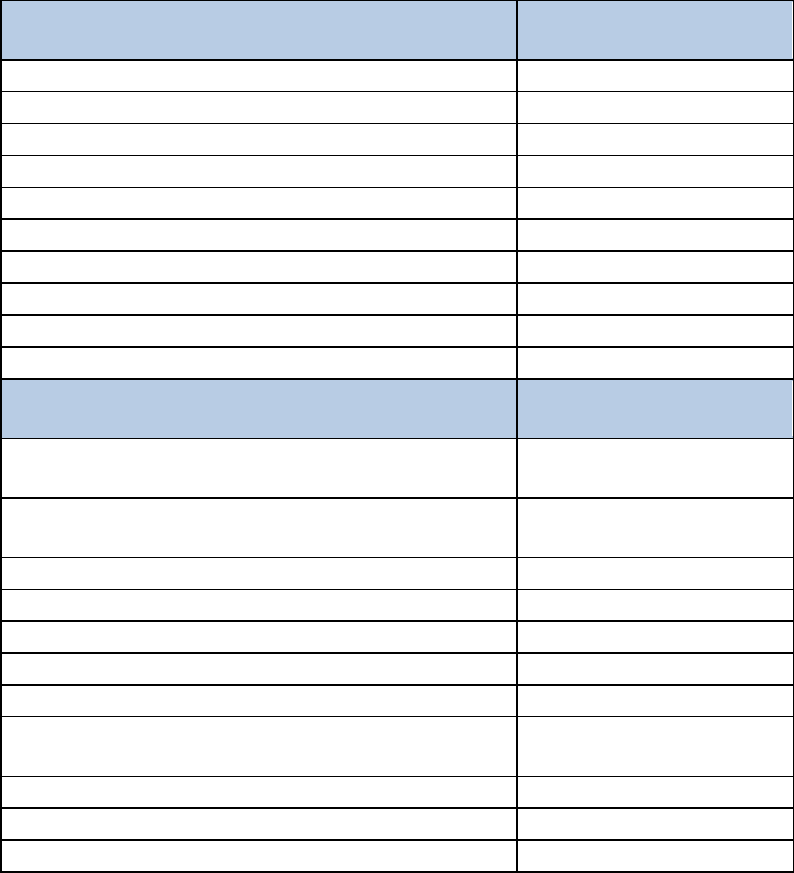
DoDM 5110.04, Volume 1, June 16, 2020
SECTION 3: GENERAL CORRESPONDENCE MANAGEMENT 11
Table 1. Action Suspense Types and Timelines
Standard Action Types
Suspense
(Business Days)
Answer SecDef Note (ASN)
5
Answer DepSecDef Note (ADN)
5
Prepare Reply for ExecSec Signature (PRE)
10
Comments and Recommendations (C&R)
5
Prepare Reply for SecDef Signature (PRS)
10
Prepare Reply for DepSecDef Signature (PRD)
10
Reply Direct by the Component Head (RDC)
14
Reply Direct (RD)
14
For Appropriate Action (FAA)
-
Information and Retention (I&R)
-
Situation or Category-Specific Action Types
Suspense
(Business Days)
President, Vice President, White House Chief of
Staff
1 calendar day
Cabinet Heads, U.S. Governors, and Senior White
House Staff
5
White House Referrals
6
Members of Congress
5
Ministers of Defense
5
White House Bulk RED-DOT Cases (RD)
5
Non-Congressional Correspondence (PRS or PRD)
10
Congressional Constituent Inquires Addressed to
ASD/LA) (RD)
10
White House Bulk Cases (RD)
14
Invitations Tasked for C&R
14
Detail Requests from Outside DoD
30
3.3. ROUTING INCOMING CORRESPONDENCE.
a. To forward incoming SecDef, DepSecDef, and ExecSec correspondence to the OSD and
DoD Components, CMD will use CATMS to:
(1) Disseminate action and information copies to the appropriate offices.
(2) Indicate what action the office of primary responsibility (OPR) will take and
establish a suspense date for the action. See Table 1 for a complete list of directed actions and
standard suspense times.
(3) Identify required coordination.
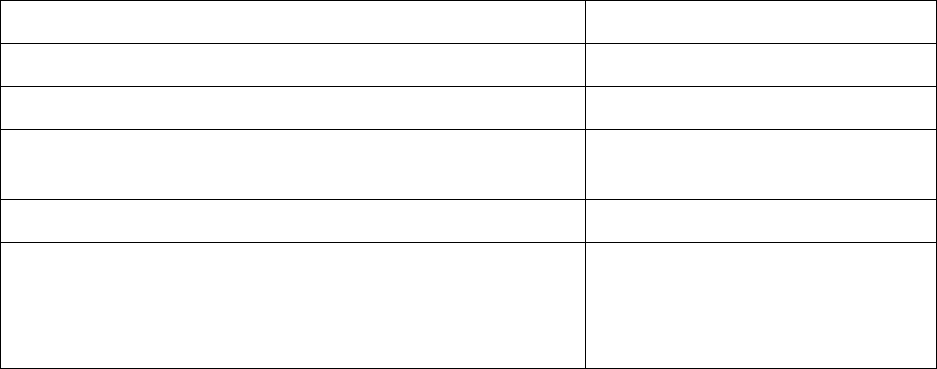
DoDM 5110.04, Volume 1, June 16, 2020
SECTION 3: GENERAL CORRESPONDENCE MANAGEMENT 12
(4) Provide specific guidance as necessary.
(5) Assign an OSD control number in accordance with Paragraph 3.1.b.
b. If correspondence is received by a Component and is addressed to the SecDef, the
DepSecDef, or the ExecSec, it must be forwarded to CMD for controlling purposes.
3.4. PROCESSING OSD AND DOD COMPONENT ACTIONS.
CCMOs must process SecDef, DepSecDef, and ExecSec materials through CMD, except those
materials in Table 2, which must be processed as indicated.
Table 2. Materials Not Processed Through CMD
Type of Material
Where to Deliver
Read-ahead material
ExecSec Confidential Assistant
Intelligence daily summaries
Executive Secretariat Rear (ESR)
Operational summaries (daily and weekly) from the
Operations Directorate of the Joint Staff
ESR
Notification to White House of Service member death
ESR
Time-sensitive communications requiring
SecDef or DepSecDef attention within 2 hours,
as confirmed by the ExecSec, who takes them directly to
the SecDef or DepSecDef
ESR
3.5. PROVIDING STATUS OR REQUESTING CHANGES TO ACTIONS.
a. Use of SD Form 391, “Secretary of Defense Correspondence Action Report.”
(1) CCMOs must submit an SD Form 391 to CMD with all action correspondence to
request the actions in Paragraphs 3.5.a.(1)(a) through 3.5.a.(1)(f). The SD Form 391 is available
at https://www.esd.whs.mil/Directives/forms/sd_forms, or can be generated from the CATMS
tasker. The SD Form 391 can be used to:
(a) Close an action.
(b) Request a suspense extension.
(c) Provide a copy of an interim reply to CMD.
(d) Request cancellation of an action.
(e) Appeal and request transfer of an assigned action to another OSD or DoD
Component.
DoDM 5110.04, Volume 1, June 16, 2020
SECTION 3: GENERAL CORRESPONDENCE MANAGEMENT 13
(f) Request downgrade of an assigned action.
(2) CMD will update CATMS with a scanned copy of the approved or disapproved SD
Form 391, and share it with the OPR.
b. Changes to Action Assignments.
(1) To appeal an action assignment, the OPR CCMO must contact CMD within 24 hours
of the date assigned in CATMS. When provided with a reasonable rationale for reassignment,
CMD will typically accept the action for transfer without further coordination and re-task the
action. If approved, CMD will assign a new suspense in CATMS, and assign to the new OPR.
(2) The OPR is responsible for coordinating all action assignment transfers after the
initial 24-hour period. When requesting a transfer, the OPR must:
(a) Ensure the Component CCMO accepts transfer of the action.
(b) Annotate the SD Form 391 with the name, office, and telephone number of the
accepting official.
(c) Forward the action to CMD. CMD will route the action to the ExecSec for final
decision.
(3) When newspaper articles, press releases, speeches by DoD officials, or policy change
announcements result in repeated public inquiries or a write-in campaign, the OPR may initiate a
transfer to the ATSD(PA) and request the Office of the ATSD(PA) be designated as the OPR for
future inquiries on the subject.
(a) When initiating a transfer to the ATSD(PA), the OPR must return the original
correspondence (if the original was received) and proposed reply to CMD along with the SD
Form 391 annotated with the name and telephone number of the ATSD(PA) accepting official.
(b) The originating OPR must provide the ATSD(PA) with information for creating
replies and updated information if circumstances change.
(4) On occasion, the SecDef or the DepSecDef, their Military or Special Assistants, or
the ExecSec may change an action assignment. In these instances, CMD will update the action
assignment in CATMS and share it with the new OPR.
(5) If the OPR requests an extension to a congressional tasking, an OPR-generated
interim response must be included in this request to change, and sent to the Office of the
ASD(LA) for approval or disapproval. The OASD(LA) POC who approves the action must be
included on the request to CMD, with a copy of the interim response.
(6) The Component approval authority for SD Form 391 depends on the type of action
and the number of extensions, and are listed in Table 3. Component heads may designate in
writing an additional senior official for this purpose by submitting an Information Memorandum
to ExecSec.
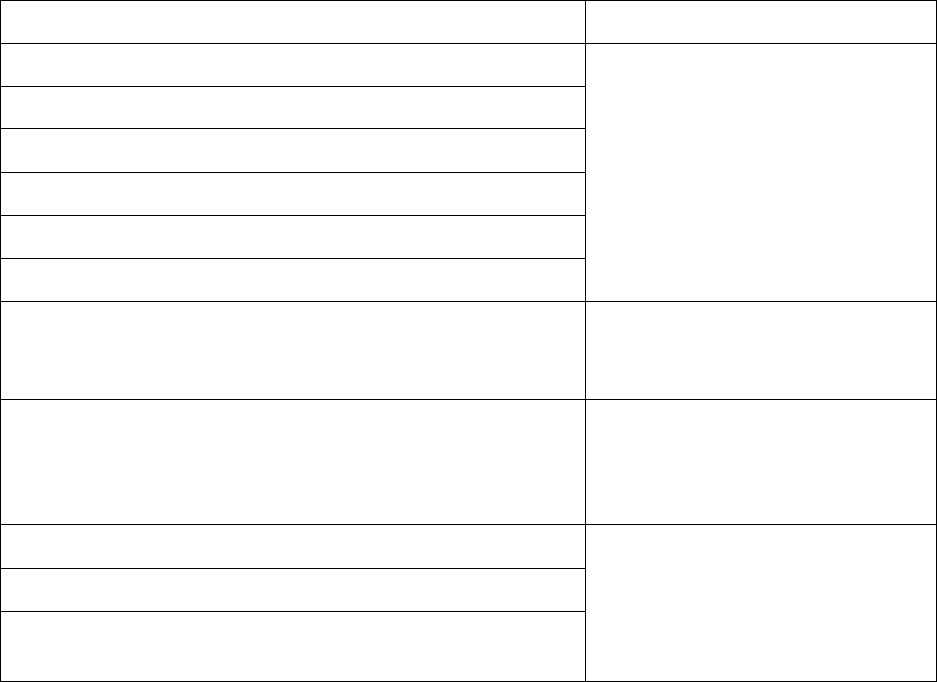
DoDM 5110.04, Volume 1, June 16, 2020
SECTION 3: GENERAL CORRESPONDENCE MANAGEMENT 14
Table 3. SD Form 391 Approval Authorities
Action Type
Approval Authority
PRS (Prepare Reply for SecDef Signature)
Component Head, Principal
Deputy, or Designated Senior
Official (Extensions Only)
PRD (Prepare Reply for DepSecDef Signature)
ASN (Answer SecDef Note)
ASD (Answer DepSecDef Note)
C&R (Comments and Recommendations)
PRE (Prepare Reply for ExecSec Signature)
RDC (Reply Direct by the Component Head)
Component Correspondence
Management Officer (1
st
and 2
nd
Extension Request)
RDC (Reply Direct by the Component Head)
Component Head, Principal
Deputy, or Designated Senior
Official (3
rd
Extension Request
and Higher)
RD (Reply Direct) – Component Level Expert
Component Correspondence
Management Officer
24-Hour Transfer Rule Request
All other changes (Upgrade, Downgrade, Cancellation,
Action Complete, etc.)
3.6. COORDINATING ASSIGNED ACTIONS.
CCMOs will coordinate with OSD and DoD Components designated in the action assignment
and any others that may have an interest in or be affected by the outcome of the action.
Coordination with those Components will be done simultaneously to ensure a timely response.
a. For correspondence prepared for the SecDef, the DepSecDef, or the ExecSec signature,
obtain concurrence or comments from the OSD and DoD Component heads or, in their absence,
from their deputies.
b. For correspondence prepared for signature of OSD and DoD Component head or below,
obtain coordination at the appropriate level as determined by the responding Component.
c. Disagreements about recommendations or a lack of response from a coordinating office
will not delay the action. To address such situations, CCMOs will:
(1) List nonconcurrences and place the comments at the coordination tab of the action
package.
DoDM 5110.04, Volume 1, June 16, 2020
SECTION 3: GENERAL CORRESPONDENCE MANAGEMENT 15
(2) Address nonconcurrence issues in the action memorandum or attached supplement.
(3) For failures to respond, note on the coordination sheet when coordination was
attempted but not accomplished.
d. If no coordination is required on an action or information memorandum (referred to in this
issuance as “action” or “info” memoranda), enter “NONE” on the coordination line. See
Paragraphs 7.3. and 7.4. for details.
e. Coordinate with the ATSD(PA) on all correspondence that:
(1) Contains information with public affairs implications.
(2) Involves requests for SecDef or DepSecDef participation in public fora, such as
speaking and media events, or in events in DoD or military settings that may draw media
coverage.
f. Coordinate with the GC DoD on all correspondence having legal implications, statutory
references, or that make the Department susceptible to legal actions.
g. Coordinate with the ASD(LA) on all correspondence to members of Congress.
h. Coordinate with the Assistant to the SecDef and DepSecDef for protocol on all SecDef
and DepSecDef schedule proposals. See Volume 2 of this manual for information on preparing
schedule proposals.
3.7. SUBMITTING MATERIALS TO THE SECDEF, THE DEPSECDEF, OR THE
EXECSEC.
CCMOs submitting materials to the SecDef, the DepSecDef, or the ExecSec will:
a. Use either an action or info memorandum. See Paragraphs 7.3. and 7.4. for details.
b. Submit packages to CMD for control and forwarding through the appropriate channels.
c. Flag correspondence requiring expeditious processing with a red flag or tab in the upper-
left corner. CMD staff must ensure these materials receive priority processing and prompt
delivery to the ExecSec.
d. Flag extremely urgent communications requiring SecDef or DepSecDef attention within 2
hours with a green flag or tab in the upper left corner and hand-carry to CMD for expeditious
processing or, if directed, hand-carry to the ExecSec.
DoDM 5110.04, Volume 1, June 16, 2020
SECTION 3: GENERAL CORRESPONDENCE MANAGEMENT 16
3.8. SUSPENSE REPORTING.
CMD must maintain correspondence suspense and status reports available to CCMOs and other
authorized personnel in CATMS at https://crm.osd.mil/CATMS1/main.aspx and select
“Component Reports.”
a. CMD will:
(1) Electronically submit the coordination report to all CCMOs before each weekly
coordination meeting.
(2) Publish and electronically dispatch the weekly stoplight report and the monthly
correspondence awards for excellence.
b. CMD may publish other correspondence tracking and suspense reports as necessary.
DoDM 5110.04, Volume 1, June 16, 2020
SECTION 4: WHITE HOUSE CORRESPONDENCE MANAGEMENT 17
SECTION 4: WHITE HOUSE CORRESPONDENCE MANAGEMENT
4.1. GENERAL PROCESSING INFORMATION.
a. OSD receives correspondence from the President, Vice President, Assistant to the
President for National Security Affairs, and senior White House staff involving national security
issues and inter-DoD affairs. The White House Military Office (WHMO) forwards
communications from the Office of the President concerning routine administrative, logistical,
transportation, military personnel, and emergency action matters not involving national security
policy to the DoD ExecSec through CMD. DoD responses to the Office of the President will be
sent to the WHMO.
b. Communications from the President or White House staff sent directly to the OSD and
DoD Components will be referred to the ExecSec.
c. Signing officials will be determined by the correspondence level.
(1) The SecDef or the DepSecDef will sign DoD correspondence to the President, the
Vice President, the Chief of Staff to the President, and the Assistant to the President for National
Security Affairs.
(2) The ExecSec will sign conveyance memoranda, forwarding routine staff-to-staff
written communications to offices within the White House and to the Deputy Assistant to the
President, the Director of WHMO, the Executive Secretary of the National Security Agency, and
the Assistant to the President for National Security Affairs.
(3) The OSD and DoD Component heads will designate appropriate level staff to sign
responses to individuals who write to the President or other White House officials when the
correspondence is sent to the DoD for reply.
4.2. ASSIGNING SUSPENSE DATES FOR WHITE HOUSE CORRESPONDENCE.
a. Incoming White House correspondence for which CMD assigns suspense dates and
processes replies falls into three categories and is tasked in accordance with Paragraph 3.2.
(1) Special.
Correspondence from the President, Vice President, Assistant to the President for
National Security Affairs, and senior White House staff. Correspondence in this category
normally involves national security issues and inter-DoD affairs.
(2) Referrals.
Correspondence containing DoD-related subject matter from members of Congress,
corporate executives, former U.S. Government officials, or foreign officials, or correspondence
DoDM 5110.04, Volume 1, June 16, 2020
SECTION 4: WHITE HOUSE CORRESPONDENCE MANAGEMENT 18
involving special interest items addressed to the President or the Vice President or brought to the
attention of the White House staff.
(3) White House Bulk.
All other routine correspondence from private citizens addressed to the President or
White House staff and forwarded to the DoD for reply.
b. Upon receipt of White House correspondence, CMD will:
(1) Task the correspondence to the responsible OPR via CATMS or, depending on topic,
provide a paper copy for distribution only.
(2) Monitor the correspondence on the open tasks list until completion.
4.3. REPLYING TO WHITE HOUSE CORRESPONDENCE.
Responsible CCMOs must prepare replies for White House correspondence according to
directions in the action assignment.
a. Draft Reply.
Draft replies must be:
(1) Prepared on plain bond paper with 1-inch margins and a space between each
paragraph.
(2) Submitted as a signature package to the ExecSec through CMD (original, plus one
copy) for forwarding to WHMO. The package must contain a:
(a) Memorandum to the ExecSec briefly explaining the case.
(b) Memorandum on OSD letterhead, to WHMO for ExecSec signature, that
provides the draft reply as an attachment.
b. Interim Reply.
When a CCMO is unable to provide a final reply by the designated suspense date, an interim
reply to the writer of the incoming correspondence must be prepared stating the:
(1) Reason for the delay.
(2) Steps being taken to obtain the necessary information.
(3) Date the writer may expect a final reply.

DoDM 5110.04, Volume 1, June 16, 2020
SECTION 4: WHITE HOUSE CORRESPONDENCE MANAGEMENT 19
c. Final Reply.
Submit final reply with Standard Form 391, “Secretary of Defense Correspondence Action
Report” for closure to CMD. CMD will close the action and respond to the White House. Copies
of replies to DoD Hotline cases are not required to be submitted to CMD; however, the Office of
the Inspector General will submit a SD Form 391 to CMD stating the action is complete.
4.4. PREPARING DOD-ORIGINATED WHITE HOUSE CORRESPONDENCE.
a. For DoD correspondence signed by the SecDef or the DepSecDef and sent to White
House officials, CCMOs will prepare materials using the appropriate letterhead in accordance
with Section 12. Such correspondence must also be forwarded using an action memorandum.
CCMOs will prepare the action memorandum in accordance with Paragraph 7.3., memorandum
in accordance with Paragraph 7.2, and the letter in accordance with Section 8.
b. Correspondence addressed to the President is privileged. Information copies of the signed
correspondence are not immediately available. However, CMD will provide OPRs a copy of the
approved action memorandum.
4.5. FORMS OF ADDRESS.
a. The addresses, salutations, and complimentary closings in Tables 4 and 5 must be used
when corresponding with the President and the Vice President.
b. The appropriate agency, building, and room number must be clearly marked on all
correspondence and envelopes addressed to the White House to ensure appropriate delivery.
Table 4. Addressing the President
Letter
Address on Letter and Envelope
Salutation and
Complimentary Close
President (Full Name)
Dear Mr./Madam
The White House President:
1600 Pennsylvania Avenue, NW
Washington, DC 20500
Respectfully yours,
Memorandum
Address on Memorandum Address on Envelope
Salutation and
Complimentary Close
MEMORANDUM FOR
President (Full Name)
None
THE PRESIDENT The White House
1600 Pennsylvania Avenue, NW
Washington, DC 20500
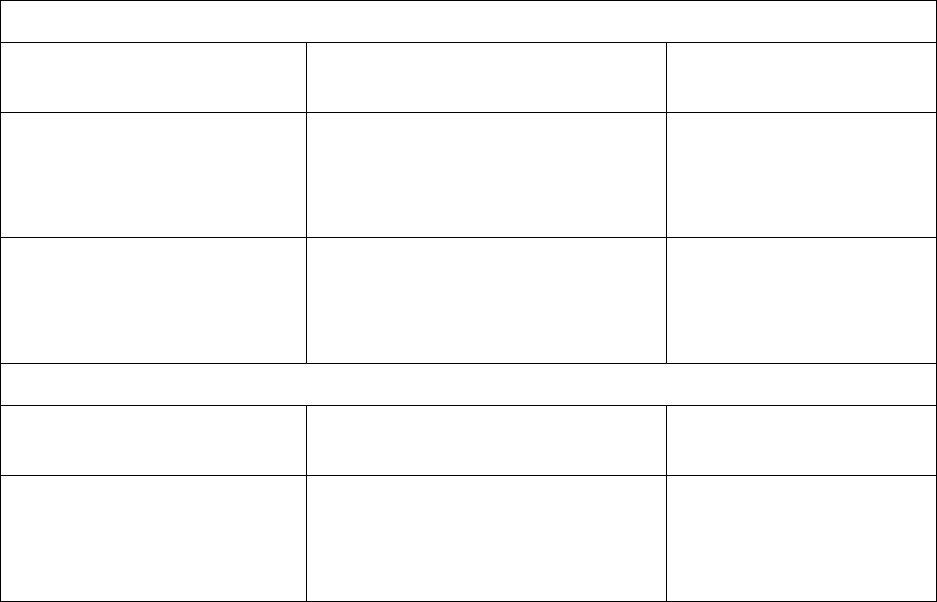
DoDM 5110.04, Volume 1, June 16, 2020
SECTION 4: WHITE HOUSE CORRESPONDENCE MANAGEMENT 20
Table 5. Addressing the Vice President
Letter
Salutation and
Addressee Address on Letter and Envelope
Complimentary Close
Vice President
Vice President
Dear Mr./Madam Vice
276 Eisenhower Executive Office President:
Building
Vice
Washington, DC 20501
President
The Honorable (Full Name)
Sincerely,
Dear Mr./Madam
as President of the Senate President of the Senate President:
S-212 Capitol Building
Washington, DC 20510-0012
Sincerely,
Memorandum
Salutation and
Address on Memorandum Address on Envelope
Complimentary Close
MEMORANDUM FOR
Vice President
None
THE VICE PRESIDENT 276 Eisenhower Executive Office
Building
Washington, DC 20501
DoDM 5110.04, Volume 1, June 16, 2020
SECTION 5: CONGRESSIONAL CORRESPONDENCE MANAGEMENT 21
SECTION 5: CONGRESSIONAL CORRESPONDENCE MANAGEMENT
5.1. CMD PROCEDURES REPORTING.
CMD will:
a. Process congressional correspondence that is:
(1) Addressed to the SecDef, the DepSecDef, the ExecSec, or the ASD(LA).
(2) Forwarded to the DoD from a member of Congress on behalf of a constituent.
b. Assign the action to the OPR and indicate the suspense date and the action required (e.g.
PRS, PRD, PRE, RDC, or RD). The suspense dates for congressional correspondence are in
Table 1.
5.2. SIGNATURE AUTHORITIES.
a. The SecDef normally signs replies to chairs and ranking members of DoD oversight
committees and congressional appropriations committees and to Senate and House leadership.
b. The DepSecDef normally signs replies to correspondence addressed to him or her from
Senate, House, and DoD oversight and appropriations committee leadership.
c. An individual appointed by the President with the advice and consent of the Senate,
someone serving in an acting or performing the duties of status for such a position, or head of a
legislative affairs liaison office may sign replies to letters referred to the Military Departments,
the Defense Agencies and Field Activities, or the OSD Components for RDC. All other
congressional correspondence signature authority is determined by the tasking type identified in
Table 1.
5.3. OFFICES OF PRIMARY RESPONSIBILITY.
OPRs will:
a. If the tasking is at the PRS or PRD level, prepare a response to the member of Congress
on the appropriate letterhead and with the appropriate signature block in accordance with
Paragraph 5.2. Prepare the letter in accordance with Section 8.
b. Coordinate the reply with the offices listed in the CATMS CMD assignment instructions
and with other organizations that may have an interest in or be affected by the response.
(1) Provide info copies to all coordinating offices.
(2) Coordinate on all correspondence addressed to members of Congress with the
ASD(LA).
DoDM 5110.04, Volume 1, June 16, 2020
SECTION 5: CONGRESSIONAL CORRESPONDENCE MANAGEMENT 22
c. Forward the coordinated reply for signature through CMD using an action memorandum.
Prepare the action memorandum in accordance with Paragraph 7.3. of this volume.
d. On DoD Component-level taskers from a member of Congress:
(1) Send RDC and RD replies directly to the member of Congress. Provide a copy of the
response and SD Form 391 to CMD, and complete the tasker in CATMS. In addition, provide a
copy to the ASD(LA).
(2) Address replies to congressional correspondence in accordance with Table 6.
(3) Provide a courtesy copy to the ranking member when sending correspondence to
chairpersons of congressional committees or subcommittees.
(4) Address a reply letter from a congressional staff member to the member of Congress
or the chair of the committee and mark the envelope to the attention of the staff member.
(5) Mark the envelope to a particular person’s attention or address to a specific location
(e.g., a home State congressional office) when the incoming correspondence requests that this be
done or the person in the congressional office is interested in, has called about, or has signed the
request for the member of Congress.
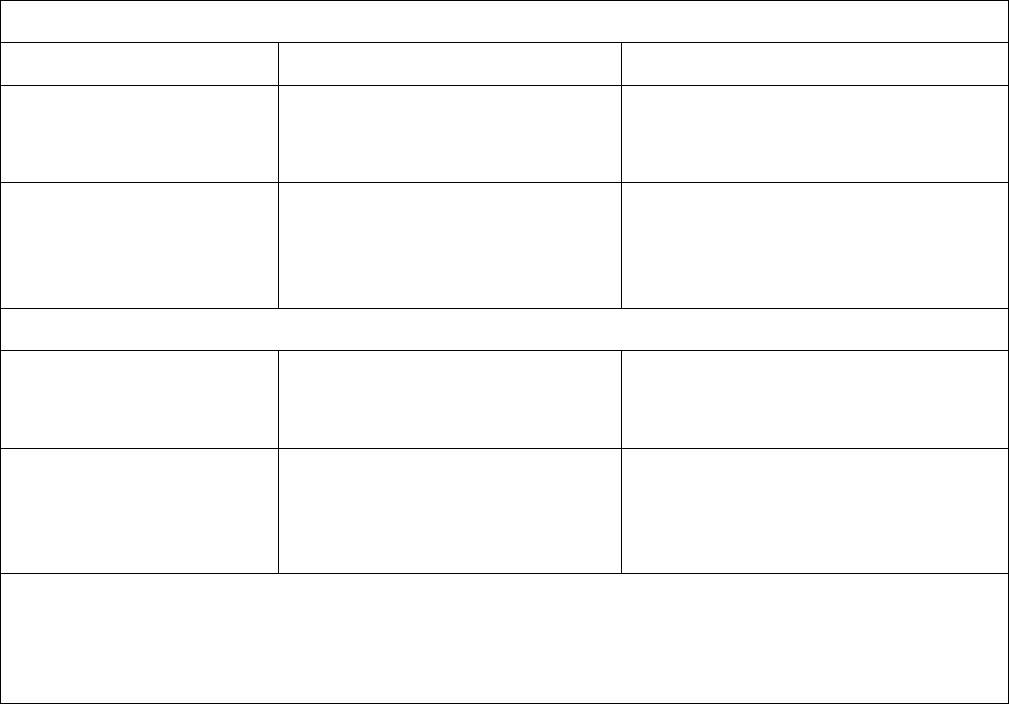
DoDM 5110.04, Volume 1, June 16, 2020
SECTION 5: CONGRESSIONAL CORRESPONDENCE MANAGEMENT 23
Table 6. Addressing Members of Congress
Senate
To
Address on Letter and Envelope
Salutation and Complimentary Close
Washington, DC, Office
The Honorable (Full Name)
United States Senate
Washington, DC 20510 (+ 4)
1, 2
Dear Senator (Last Name):
Sincerely,
Home State Office
The Honorable (Full Name)
United States Senator
(Address)
Dear Senator (Last Name):
Sincerely,
House
Washington, DC, Office
The Honorable (Full Name)
U.S. House of Representatives
Washington, DC 20515 (+ 4)
1, 2
Dear Representative (Last Name):
Sincerely,
Home State Office
The Honorable (Full Name)
United States Representative
(Address)
Dear Representative (Last Name):
Sincerely,
1
May include “(+4)” if available. The nine-digit ZIP codes (ZIP+ 4) for individual members of U.S. House of
Representatives, and Senate Congressional Directory may be found on their respective websites.
2
Congressional correspondence signed by the SecDef, DepSecDef, or ExecSec is couriered. As such, when preparing
Congressional correspondence for SecDef, DepSecDef, or ExecSec signature, it is not necessary to include the last four
digits of the ZIP code in the address.
DoDM 5110.04, Volume 1, June 16, 2020
SECTION 6: WRITING STYLE AND PREFERRED USAGE 24
SECTION 6: WRITING STYLE AND PREFERRED USAGE
6.1. GENERAL GUIDELINES.
Whether writing a memorandum for SecDef information or action or drafting a letter for SecDef
signature, DoD correspondence must adhere to the highest standards of clarity and
professionalism in accordance with DoDI 5025.13. Because correspondence is often drafted by
persons other than the signer, it is important to consider these guidelines in the context of both
the sender and the recipient of the communication:
a. Action and Info Memoranda.
Action and info memoranda should be concise. Each memorandum objective will dictate the
length, but generally each memorandum should provide only the material necessary for action or
“bottom line up front” information; extensive background information and supporting material
should be attached. See Section 7 for guidance on structuring memoranda.
b. Correspondence for Principals’ Signature.
Regardless of the routine or customary nature of any individual piece of correspondence, all
items signed by the SecDef, the DepSecDef, or the ExecSec must be of the highest quality.
Writers must consider the signer as well as the addressee and adapt the correspondence
accordingly.
c. References.
Good writing skills develop with time, training, and experience. If specific guidance is not
provided in volume, writers must use the U.S. Government Publishing Office Style Manual,
including supplements, as the authority for answers to questions concerning punctuation,
capitalization, numerals, compound words, writing style, etc. Other possible references include
the Chicago Manual of Style and the Gregg Reference Manual as long as they do not conflict
with the U.S. Government Publishing Office Style Manual, or this issuance. Spelling is in
accordance with Merriam-Webster’s New Collegiate Dictionary.
6.2. PREPARATION.
Preparation is the first step to good writing. The writer must assess the subject, audience, and
purpose of the communication and keep these in mind throughout the writing process. These
elements of preparation are interrelated and can be assessed simultaneously:
a. Subject Line on Memoranda and Messages.
(1) In DoD memoranda and messages, the OPR may determine the subject. Clarifying
and refining the subject help the writer organize and present the most relevant information
clearly. These questions assist in refining the subject:

DoDM 5110.04, Volume 1, June 16, 2020
SECTION 6: WRITING STYLE AND PREFERRED USAGE 25
(a) What is the assignment or question?
(b) What does the audience need or want to know?
(c) How specific or general should the communication be?
(2) Action and info memoranda should be limited to a single subject. If it is necessary to
communicate information about multiple subjects, the writer should consider using separate
memoranda.
(3) The subject line should clearly communicate the subject in one or two lines. The
writer should avoid vague, one-word subjects and use instead specific descriptions that indicate
or summarize the content of the memorandum or message, as shown in Table 7.
Table 7. Examples of Vague Subjects and Suggested Alternatives
Vague Subjects
Specific, Descriptive Subjects
SUBJECT: Iraq
SUBJECT: October 2018 Assessment of Iraq Provincial
Reconstruction Teams
SUBJECT: Budget Issues
SUBJECT: Budget Projections for Fiscal Year 2018
b. Audience.
(1) Official DoD correspondence should have a specific audience. Determining the
audience helps tailor the message and present information in the most appropriate way. When
drafting correspondence for SecDef or DepSecDef signature, the audience may be an OSD
Component head, a member of Congress, the President of the United States, or family members
of a fallen Service member. Writers should carefully consider the audience from the perspective
of the signer.
(2) These questions assist in determining the audience:
(a) Who will read this communication?
(b) What is the signer’s relationship to the audience?
(c) What does the audience already know about this subject?
(d) What tone should be used to address this audience (e.g., formal, informal)?
c. Purpose.
(1) DoD official correspondence must have a specific purpose. Like the subject of a
memorandum or message, the purpose of correspondence may be determined by an assignment
or initiated by the generating organization. Common purposes include:
(a) Providing options or recommendations.
DoDM 5110.04, Volume 1, June 16, 2020
SECTION 6: WRITING STYLE AND PREFERRED USAGE 26
(b) Requesting authorization.
(c) Reporting or summarizing information.
(d) Evaluating, analyzing, or interpreting data.
(2) These questions help refine the purpose:
(a) What is the aim of the assignment?
(b) What must this communication accomplish?
(c) How can its purpose best be achieved?
6.3. ORGANIZATION, CLARITY, AND STYLE.
DoD correspondence must neither be so brief that it lacks clarity, nor so wordy that it clouds
rather than illustrates the message. There is no one-size-fits-all formula for writing style; a
meeting summary will be different in style than a letter of condolence. By applying the basic
principles of organization and clarity, a writer can communicate the essential information clearly
and completely, in a style most appropriate to the message.
a. Organization.
The organization of a document should flow logically from refinement of the subject,
audience, and purpose. The organizational scheme should fit the subject and purpose and ideas
should be organized according to the scheme.
(1) Common Organizational Schemes.
(a) Chronological.
Arrange events in sequential order, from first to last.
(b) Systematic.
Arrange events, people, or things according to their placement in a system or process.
(c) C&R (or problem and solution).
Provide background information and evaluate a situation; then provide one or more
options or recommendations for future action.
(d) General to Specific.
Arrange by main point or points and fill in supporting details, examples, and
illustrations.

DoDM 5110.04, Volume 1, June 16, 2020
SECTION 6: WRITING STYLE AND PREFERRED USAGE 27
(2) Outlining.
See Volume 2 of this manual for information on using an outline to develop the
organizational scheme.
(3) Transitions.
Transitional phrases are used to highlight organization, to facilitate the flow of writing
from point to point, and to improve clarity and readability. Table 8 provides a list of transitional
phrases and their uses.
Table 8. Transitional Words and Phrases
Use
Transitional Words and Phrases
Time or Sequence
–
–
first, second, third...
first, next, last...
–
–
–
–
–
once, then, finally
again, also, and
afterward, following, at length, since
before, formerly, lately
now, meanwhile, currently, simultaneously
Comparison or Contrast
–
–
–
–
likewise, similarly, in the same way
but, yet, however, nevertheless, while, still
despite, in spite of, regardless, in contrast
on one hand, on the other hand
– instead, on the contrary, otherwise
Illustration or Expansion
–
–
–
for example, for instance
moreover, furthermore, namely
incidentally, indeed, in fact
Summary or Conclusion
–
–
in conclusion, in summary
to conclude, to summarize
– therefore
Cause or Effect
–
–
as a result, consequently, since
accordingly, because, therefore
(4) Bullets.
Bullets provide a simple format for structuring main ideas or listing supporting ideas,
concepts, items, or steps. They facilitate efficient communication by marking portions of text to
indicate divisions and relationships among concepts within a communication. See Sections 7
and 8 for examples of bullets in DoD correspondence.
(a) Bullets for Main Ideas.
Bullets should be used to illustrate main ideas in standard, action, and info
memoranda, except that they may not be used for main ideas in letters or memoranda for SecDef
or DepSecDef signature. One bullet should be used for each paragraph. Transitional words
DoDM 5110.04, Volume 1, June 16, 2020
SECTION 6: WRITING STYLE AND PREFERRED USAGE 28
(“moreover,” “finally,” etc.) should not be used to lead off bullets if their use would be
redundant.
(b) Bullets for Supporting Ideas.
If it would facilitate communication, bullets and sub-bullets within bulleted
paragraphs may be used to illustrate significant supporting ideas that relate directly to the main
idea. Complete sentences should be used to express supporting ideas. Bullets and sub-bullets
should be avoided if the ideas are simple enough to be stated clearly in the text of the paragraph
or would be more clearly expressed by use of transitional phrases.
(c) Bullets for Lists.
Bullets may be used to list concepts, items, or steps when the list is ordinal or
sequential. There must be at least two items in the list. An introductory phrase should present
the points that follow, and each bullet should begin with the same type of word (e.g., a verb or a
noun) in the same tense and voice.
b. Clarity and Style.
Because of the nature of the DoD mission, clarity is of utmost importance in DoD
communication. Clarity may be achieved by identifying the actors in the text and clearly linking
them to specific, meaningful actions. Asking the question, “Who does what?” helps identify
actors and actions.
(1) Active Versus Passive Voice.
One major obstacle to clear communication is excessive use of passive voice. See Table
9 for examples of active and passive voice.
(a) Active Voice.
Normal English sentence structure follows the actor – action – object pattern, or “who
does what to whom.” For example, “Bill (actor) gave (action) Jimmy (object) the car (object).”
(b) Passive Voice.
The passive voice substitutes the actor with the object, using the verb “to be” and a
past participle. For example, “The car was given to Jimmy” or “Jimmy was given the car.” The
passive voice lacks clarity because it does not identify the actor.
(c) Exceptions.
In some situations, the passive voice is necessary or preferable to the active voice.
Generally, however, use of the active voice produces greater clarity because it states who does
what, usually in fewer words.

DoDM 5110.04, Volume 1, June 16, 2020
SECTION 6: WRITING STYLE AND PREFERRED USAGE 29
Table 9. Examples of Passive Voice and Suggested Alternatives
Passive Voice
Active Voice
Frequently omits the doer of the action.
An information copy of the board meeting
minutes must be forwarded to the members.
A military chaplain of a particular religious
organization may be appointed as a
consultant.
Identifies the doer.
The Chair must forward an information copy
of the board meeting minutes to the members.
The Board may appoint a military chaplain of
a particular religious organization as a
consultant.
Frequently is longer and less direct;
frequently includes a “by” phrase.
A written agreement will be executed by the
parties.
Implementing instructions will be issued by
the DoD Components
Gets to the point.
The parties execute a written agreement.
The DoD Components issue implementing
instructions.
(2) Weak Verb Phrases.
Writers should use strong, simple, active verbs to describe specific actions, rather than
weak verb phrases that rely on the verbs “to be” or “to have” to complete the action. Such
phrases obscure meaning and result in wordy, ambiguous sentences. Writers should also avoid
the phrases “there is” and “there are,” which detach the actor from the action, resulting in vague
communication. See Table 10 for guidance on eliminating weak verb phrases.
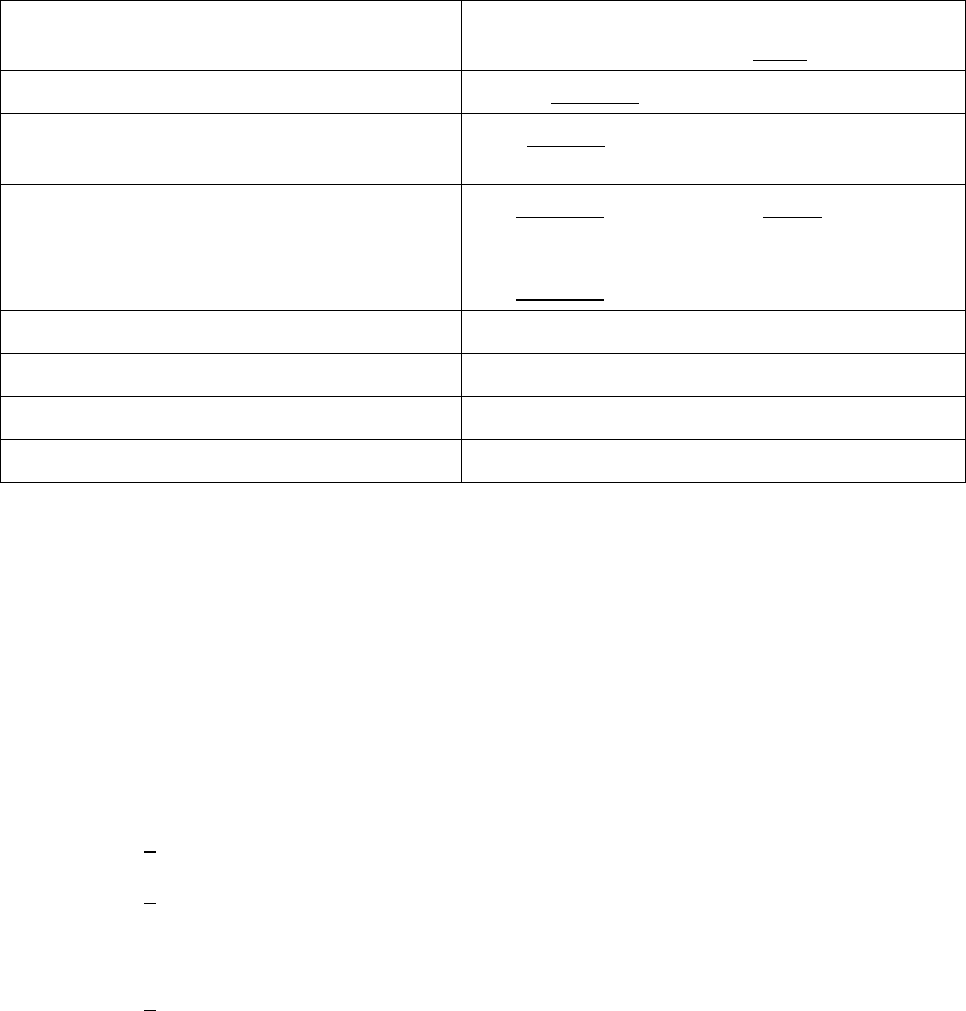
DoDM 5110.04, Volume 1, June 16, 2020
SECTION 6: WRITING STYLE AND PREFERRED USAGE 30
Table 10. Examples of Weak Verb Phrases and Suggested Alternatives
Instead of
Weak Verb Phrases
Use
Strong Active Verbs (Actor, Action)
There were several members in attendance.
Several members attended.
It is incumbent upon each member to
ensure a POC is identified.
Each member must identify a POC.
The members were in agreement that the
policy was in need of revision.
The members agreed that the policy should be
revised.
– or –
The members agreed to revise the policy.
…made a suggestion…
…suggested…
…was desirous of…
…wanted…
…has a requirement…
…requires…
…came to a decision…
…decided…
(3) Subject-Verb Agreement.
Problems with subject-verb agreement result in confusing and sometimes embarrassing
writing. Writers must ensure that the verb of the sentence applies correctly to the subject. See
Table 11 for subject and verb guidelines.
(a) Writers may have trouble identifying problems with subject-verb agreement when
the subject and the verb are far removed from each other in a sentence.
(b) A sentence with more than one subject may require a singular or plural verb
depending on how the subjects are related.
1. Two or more subjects joined by “and” usually require a plural verb.
2. If multiple subjects are joined by “or” or “nor,” the noun closest to the verb
dictates the form. If a subject contains a singular noun and a plural noun, the plural noun should
be placed closer to the (plural) verb to enhance readability.
3. Some indefinite pronouns, when used as subjects, require only singular verbs
(e.g., “anyone,” “anything,” “each,” “either,” “everyone,” “everything,” “much,” “neither,”
“none,” “nothing,” “someone,” and “something”).
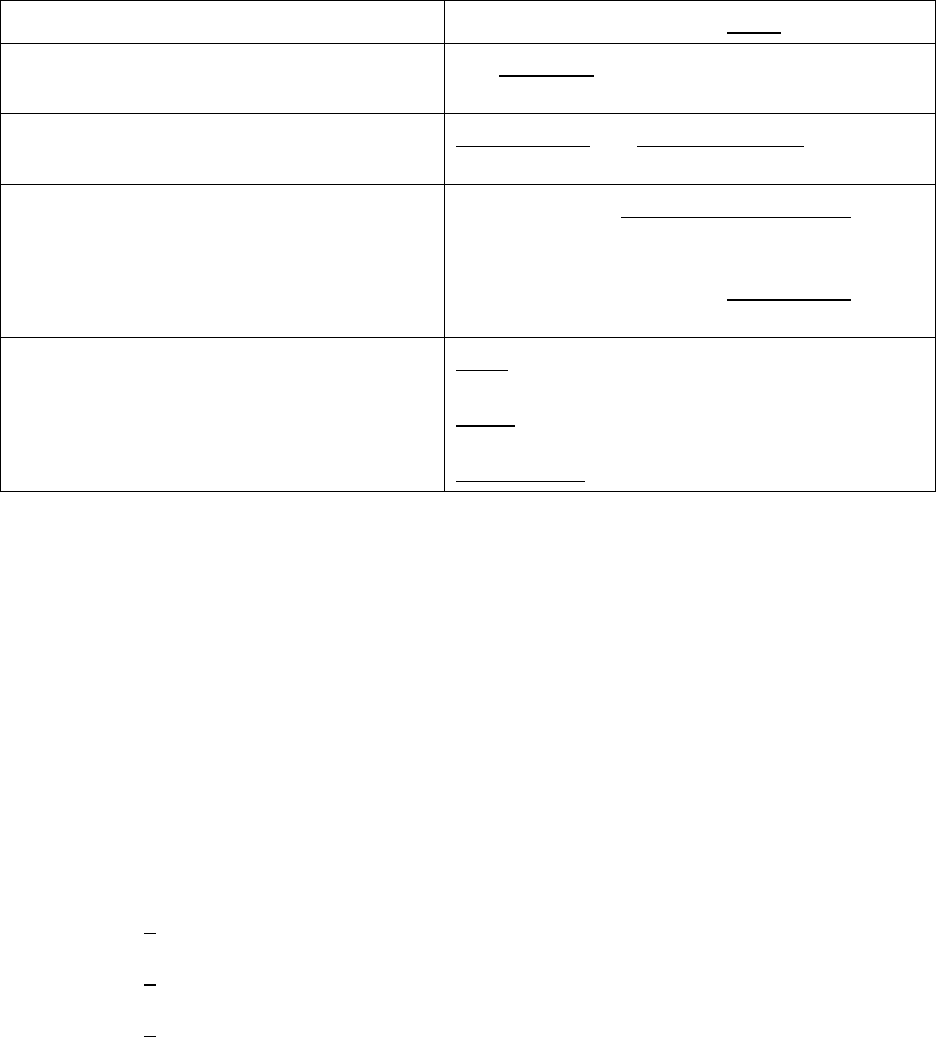
DoDM 5110.04, Volume 1, June 16, 2020
SECTION 6: WRITING STYLE AND PREFERRED USAGE 31
Table 11. Subject-Verb Agreement Guidelines
Sentence Structure
Subject-Verb Agreement (Actor, action)
Subject and verb separated by several
words: Make sure subject and verb agree.
The handbook of rules and regulations contains
[not contain] important safety information
Subjects joined by “and:” Use plural verb.
The Secretary and Deputy Secretary agree [not
agrees] on this proposal.
Subjects joined by “or:” Determined by
the subject nearest the verb.
The chairman or the committee members decide
the issue.
The committee members or the chairman
decides the issue.
Singular indefinite pronouns used as
subjects.
None of the options is viable.
Either option is viable.
Each mission requires significant resources.
6.4. CAPITALIZATION, PUNCTUATION, AND USAGE.
This paragraph provides basic instructions for standardizing English usage in DoD
correspondence; it is not exhaustive. Detailed guidance is provided in the U.S. Government
Publishing Office Style Manual.
a. Capitalization.
(1) General Rules.
(a) A common noun or adjective forming an essential part of a proper name is
capitalized; the common noun used alone as a substitute for the name of a place or thing is not
capitalized. For example:
1. Massachusetts Avenue; the avenue.
2. Committee Chair John Smith; the committee chair.
3. Defense Acquisition Guidebook; the guidebook.
(b) Capitalize titles of documents, publications, papers, acts, laws, etc. Capitalize all
principal words in titles (title case); do not capitalize definite or indefinite articles (e.g., “a,”
“an,” “the”), prepositions (e.g., “by,” “for,” “in,” “to”), or conjunctions (e.g., “and,” “but,” “if”),
except as the first word of the title. For example:

DoDM 5110.04, Volume 1, June 16, 2020
SECTION 6: WRITING STYLE AND PREFERRED USAGE 32
1. For a report title: “Secretary of Defense Annual Report to Congress on the
Activities of the Western Hemisphere Institute for Security Cooperation for 2017.”
2. For a newspaper: The article appeared in “The Washington Post.”
(2) Capitalization Rules Specific to DoD Writing.
(a) Use title case for the subject line of a memorandum in accordance with Paragraph
7.2.l.
(b) Use UPPERCASE for the actual titles of military operations (e.g., “Operation
ENDURING FREEDOM,” “Operation IRAQI FREEDOM”) and for the names of the
Combatant Commands when abbreviated (e.g., “USCENTCOM,” “USINDOPACOM”).
(c) Capitalize the terms “Nation,” “Union,” “Administration,” “Confederation,”
“Commonwealth,” and “Members” only if used as part of proper names, except “Nation” is
capitalized when referring to the United States. Also capitalize “Federal” and “Government”
when referring to the United States.
(d) Do not capitalize “soldiers”, “sailors,” “airmen,” “marines,” “ally,” “allies,” and
“coalition” unless used in conjunction with a proper noun.
Table 12. Examples of DoD-Specific Capitalization
DoD-specific capitalization is bolded for emphasis in these examples:
Any nation seeks to protect its interests.
The Colonel is a national hero.
He brings great credit upon the Nation. (Referring to the United States.)
The Federal Government employs thousands of people. (Referring to the U.S. Government.)
The Agency for International Development is a Federal agency. (Referring to a U.S. Federal
agency.)
The agency works for Government reform. (Referring to the U.S. Government.)
The agency works for reform of the Haitian government.
The Chief of Staff of the Army thanked the Service member for her service.
b. Acronyms and Abbreviations.
(1) Use acronyms only when the term occurs more than once in the body of the
document.
(2) Do not use or introduce acronyms in a subject line.
(3) Write out terms as they first appear in the text and place the abbreviation or acronym
in parentheses immediately after the term. For example, “The Director of Administration and
Organizational Policy, Office of the Chief Management Officer of the Department of Defense
(DAOP OCMO) will provide policy guidance.”

DoDM 5110.04, Volume 1, June 16, 2020
SECTION 6: WRITING STYLE AND PREFERRED USAGE 33
(4) Use U.S. Postal Service abbreviations for addresses only; spell out State names in the
body of the correspondence.
(5) Spell out “United States” when used as a noun. When used as an adjective, or when
preceding the word “Government” or the name of a government organization, use “U.S.” (no
spaces). Always spell out the term “United States” when it appears in a sentence containing the
name of another country. For example:
(a) They are studying the foreign policy of the United States.
(b) The students are interested in U.S. foreign policy.
(c) The United States-Japan relationship is strong.
(6) For military rank abbreviations by Military Service and rank or pay grade, see
Volume 2 of this manual.
c. Punctuation.
(1) Apostrophe.
The apostrophe is used to show possession or to form a contraction.
(a) Do not use contractions in formal DoD correspondence; instead spell out each
word. For example, use “do not” instead of “don’t.”
(b) Use apostrophes to show possession:
1. For singular or plural nouns not ending in “s,” add “’s.” For example:
a. This is Timothy’s book.
b. I am the child’s teacher.
c. I am the children’s teacher.
2. For plural nouns ending in “s,” add an apostrophe only. For example:
a. The teachers’ proposal includes three separate provisions.
b. We must reconcile the committee members’ schedules.
3. If more than one noun possesses an object, add “ ’s” to the noun nearest the
object. For example, “I approve of George and Ted’s system” (e.g., the system belonging to
George and Ted).
4. If more than one noun possesses multiple objects, add “ ’s” to both nouns. For
example, “I approve of George’s and Ted’s systems” (e.g., George and Ted each developed
separate systems).

DoDM 5110.04, Volume 1, June 16, 2020
SECTION 6: WRITING STYLE AND PREFERRED USAGE 34
(2) Comma.
The comma is the most common form of punctuation and is used to separate elements of
a sentence, enhance readability, and improve clarity by signaling to the reader a logical break in
the flow of text. However, excessive use of commas can clutter the text. Use commas
consistently and exercise judgment in observing these guidelines:
(a) Use a comma to set off parenthetic words, phrases, or clauses, or introductory or
pertinent material. For example:
1. It is obvious, therefore, that this office cannot function.
2. In other words, the meeting was cancelled.
3. Mrs. Jones, the committee representative, conducted the meeting.
(b) Use an Oxford comma to separate items in a series of three or more. For
example:
1. The supply team provided a telephone, a computer, and a scanner.
2. Mr. Winston, Mrs. Jones, and I attended the meeting.
(c) Use a comma in numbers containing four or more digits, except in serial numbers
and dates. For example:
1. The case is OSD012345-19.
2. The estimated cost for implementation is $2,300,000.
3. The general recommended redeploying 22,000 troops.
(3) Semicolon.
(a) The semicolon, similar to but stronger than the comma, indicates a break in the
flow of a sentence and is primarily used to separate independent or coordinate clauses in the
same sentence.
(b) Use a semicolon to emphasize the close association, either in similarity or
contrast, of two clauses where separate sentences would be too strong. For example:
1. The car would not move; it was broken.
2. The meeting began well; however, several attendees arrived late.
(c) Use a semicolon to separate items in a series of three or more when the items are
lengthy or contain internal punctuation. For example, “The meeting was attended by the
Director of Administration, Office of the Chief Management Officer of the Department of

DoDM 5110.04, Volume 1, June 16, 2020
SECTION 6: WRITING STYLE AND PREFERRED USAGE 35
Defense; Director, Washington Headquarters Services; and the Chief, Correspondence
Management Division.”
(d) Avoid excessive use of the semicolon; it diminishes readability.
(4) Colon.
(a) Use a colon to join two clauses where the essence of the second clause derives so
directly from the first clause by explanation or illustration that separate sentences would weaken
the meaning. For example:
1. The directions were clear: proceed to step two.
2. An opening appeared: the team advanced.
(b) Also use a colon to introduce any matter that forms a complete sentence,
question, quotation, or list. For example:
1. The doctor gave this assessment: “The patient is doing well.”
2. We need the following items: a telephone, a computer, and a scanner.
(5) Quotation Marks.
(a) Use quotation marks to enclose direct quotations, descriptive designations, and
titles of articles and publications. For example:
1. The document was marked “SECRET.”
2. I received a copy of the report, “Defense Strategy for the 21st Century.”
3. You asked the question: “Why are the numbers so low?”
(b) Enclose needed punctuation within quotation marks unless the meaning would
otherwise be impaired. For example:
1. Punctuation within quotes: He asked, “Is this the correct copy?”
2. Punctuation outside of quotes: Can we be sure this is the “correct copy”?
(6) Punctuation Spacing.
For colons and periods, place two spaces between the punctuation and the text that
immediately follows it. For commas and semicolons, place one space between the punctuation
and the text that immediately follows it.
d. Numbers.
(1) Use numerals for single numbers of 10 or more. For example:
DoDM 5110.04, Volume 1, June 16, 2020
SECTION 6: WRITING STYLE AND PREFERRED USAGE 36
(a) The team consisted of about 40 men.
(b) The incident occurred on two separate occasions.
(2) When 2 or more numbers appear in a sentence and 1 of them is 10 or larger, use
numerals for each number (e.g., “About 40 men competed in 3 separate events.”).
(3) Spell out numbers if they begin a sentence (e.g., “Seventy-five percent of
respondents viewed the case favorably.”).
(4) Use numerals to express units of measurement, time, or money. For example:
(a) We will meet at 4 o’clock.
(b) The convoy marched 3 kilometers.
(c) Lunch will be provided for 5 dollars.
e. Dates.
(1) The preferred date format is “month day, year” (e.g., “Your February 23, 2018
memorandum clearly illustrates the policy.”).
(2) The more traditional “month day, year,” format is also acceptable (usually in more
formal communication such as letters, award citations, etc.), but should always be followed by a
comma unless it closes the sentence (e.g., “Your February 23, 2018, memorandum clearly
illustrates the policy.”).
(3) Avoid using ordinal numbers in dates (e.g., use “February 5,” not “the 5th of
February”).
f. Commonly Confused Words.
Table 13 provides examples of words writers commonly confuse and their meanings.

DoDM 5110.04, Volume 1, June 16, 2020
SECTION 6: WRITING STYLE AND PREFERRED USAGE 37
Table 13. List of Commonly Confused Words
Word
Sometimes Confused With
Accept (to receive)
Except (other than)
Advice (an opinion)
Advise (to give advice)
All ready (prepared)
Already (by this time)
Allude (to refer to indirectly)
Elude (to avoid)
Allusion (indirect reference)
Illusion (erroneous belief or conception)
Among (more than two alternatives)
Between (only two alternatives)
Ascent (a rise)
Assent (agreement)
Beside (next to or near)
Besides (in addition to)
Born (brought into life)
Borne (carried)
Brake (stop)
Break (smash)
Capital (the seat of government)
Capitol (the building where a legislature meets)
Cite (to quote an authority)
Site (a place)
Compliment (praise)
Complement (completes)
Continually (closely recurrent intervals)
Continuously (without pause or break)
Council (a group)
Counsel (to give advice)
Descent (a movement down)
Dissent (disagreement)
Desert (to abandon)
Dessert (a course after dinner)
Discreet (reserved, respectful)
Discrete (individual or distinct)
Elicit (to bring out)
Illicit (unlawful)
Farther (expresses distance)
Further (expresses degree)
Formally (conventionally)
Formerly (in the past)
Imply (to hint at or suggest)
Infer (to draw a conclusion)
Insure (to procure insurance on)
Ensure (to make certain)
Lay (to place)
Lie (to recline, stretch out)
Lessen (to make less)
Lesson (something learned)
Moneys (currency)
Monies (amount of money)
Morale (a mood)
Moral (right conduct)
Principal (most important)
Principle (basic truth or law)
Raise (to build up)
Raze (to tear down)
Stationary (unmoving)
Stationery (writing paper)
Their (belonging to them)
There (the opposite of here)
To (toward)
Too (also)
Who (refers to people)
Which (refers to things)
DoDM 5110.04, Volume 1, June 16, 2020
SECTION 7: MEMORANDA 38
SECTION 7: MEMORANDA
7.1. WHEN TO USE A MEMORANDUM.
a. Use memoranda for correspondence within the DoD, with the President and the White
House staff, and to send routine material to other federal agencies. All templates can be found
on the CMD website, https://www.esd.whs.mil/CMD/templates.
b. Memorandum types are determined by their purpose.
(1) Standard Memorandum.
Used for routine correspondence within the DoD and to other federal agencies.
(2) Action Memorandum.
Used for:
(a) Forwarding material that requires SecDef, DepSecDef, or ExecSec approval or
signature.
(b) Describing a problem and recommending a solution.
(3) Info Memorandum.
Used to convey information to the SecDef, the DepSecDef, or the ExecSec on important
developments not requiring action at the time (e.g., for background and issue papers). See
Volume 2 of this manual for information on talking and point papers.
(4) Multi-addressed Memorandum.
Used for correspondence addressed to more than one addressee.
7.2. PREPARING STANDARD MEMORANDA.
See Figures 1 and 2 for sample standard memoranda.
a. Stationery.
Use 8.5 by 11-inch letterhead. Use bond paper for succeeding pages. When preparing for
the signature of the:
(1) SecDef.
Use SecDef letterhead.
DoDM 5110.04, Volume 1, June 16, 2020
SECTION 7: MEMORANDA 39
(2) DepSecDef.
Use DepSecDef letterhead.
(3) ExecSec or Special Assistant(s) to the SecDef or DepSecDef.
Use OSD letterhead.
(4) OSD and DoD Component Heads.
Use the appropriate Component letterhead.
b. Margins.
Use a 1.75-inch top margin and 1-inch side and bottom margins on the first page. The top
margin may be adjusted up to 1.75 inches and, if not printed on letterhead (memoranda with
multiple co-signers, memoranda of agreement, etc.), up to 1 inch. For succeeding pages, use 1-
inch margins on all sides. If memoranda contain less than 11 lines, side margins may be
increased to 2 inches. Do not justify right margins.
c. Font.
Use 12-point Times New Roman.
d. Spacing.
Single-space within a paragraph for all memoranda of two or more paragraphs. Always
double-space between paragraphs and bullets, and between lines in memoranda of a single
paragraph of eight lines or less.
e. Indentation.
Indent paragraphs .5 inch from the left margin; indent subparagraphs an additional .5 inch.
f. Paragraphing.
Use bullets, numbers, or lower-case letters for subparagraphs. Do not begin a paragraph near
the end of a page unless there is room for at least two lines on that page. Do not carry a
paragraph over to the next page unless there are at least two lines on that page. Do not use one-
sentence paragraphs.
g. Page Numbering.
Do not number the first page.
(1) For second and succeeding pages, place the page number(s) at the bottom center of
the page at least a double-space (one blank line) below the last line of text and 1/2 inch from the
bottom of the page.

DoDM 5110.04, Volume 1, June 16, 2020
SECTION 7: MEMORANDA 40
(2) If classification banners are used, place the page number on a double-space above the
banner.
h. Date.
Insert the date a double space below the last line in the letterhead or department seal, ending
at the right margin. Use the month, day, year format (e.g., February 12, 2019), showing the day
and year in numerals. Omit the date on memoranda for SecDef, DepSecDef, or ExecSec
signature.
i. Address Line.
(1) For single addressees:
(a) Insert “MEMORANDUM FOR” a double-space below the date line. Include the
addressee’s title and the name or office symbol of the organization, providing enough
information to ensure the memorandum will be delivered appropriately.
(b) If more than one line is required for an addressee, indent the second line an
additional two spaces so that the first character of the indented line is below the third character of
the addressee title on the line immediately above.
(2) For multiple addressees:
(a) Type each on a single line aligned block style below and to the right of
“MEMORANDUM FOR.” See Paragraph 7.5.b. for directions on how to order multiple
addressees.
(b) If there are more than 16 addressees:
1. Enter “MEMORANDUM FOR: SEE DISTRIBUTION” a double-space below
the date line.
2. Enter “DISTRIBUTION:” a double-space below the last line of the signature
block or attachment notation, aligned with the left margin.
a. List the addressees single-spaced below the caption, beginning at the left
margin. Use title case.
b. For DoD-internal distribution list recipients, place recipients in the order
they would appear in a DoD standard multiple-addressee memorandum listing.
c. When the distribution copy recipient name or title extends to succeeding
lines, indent the second and subsequent lines two spaces so that the first character of the indented
line begins beneath the third character of the first line.
d. Place the entire distribution list on a separate page if there is not room for
all addressees on the first page.

DoDM 5110.04, Volume 1, June 16, 2020
SECTION 7: MEMORANDA 41
e. If the document will fit on one page, it is acceptable to list more than 16
addressees.
j. Attention Line.
When directing memoranda to the attention of a particular person within an organization,
type “ATTN:” followed by the name or title of the person in parentheses. Place it a single space
below and aligned under the third character of the office address. See Table 14 for samples.
Table 14. Sample Attention Lines in Memoranda
MEMORANDUM FOR SECRETARY OF THE ARMY
(ATTN: LTC BROWN)
UNDER SECRETARY OF DEFENSE FOR POLICY
(ATTN: MR. SMITH)
– OR –
MEMORANDUM FOR DIRECTOR OF OPERATIONAL TEST AND EVALUATION
(ATTN: MR. PUBLIC)
k. Through Line.
Avoid addressing memoranda to the SecDef or the DepSecDef through another office or
person whenever possible.
(1) When necessary, type “THROUGH:” a double-space below the address line and a
double-space above the subject line. Type the “THROUGH:” office in all caps.
(2) The submitting DoD Component must accomplish the through line coordination
before submitting the memorandum to CMD for control unless the through office is a SecDef or
DepSecDef immediate office, such as SecDef Protocol.
l. Subject Line.
Type “SUBJECT:” a double-space below the last line of the address line. Two spaces after
the colon, briefly describe the memorandum’s content, capitalizing the first word and all
principal words. If more than one line is required, begin succeeding lines aligned below the first
word in the subject line.
m. References.
Avoid using references in memoranda for SecDef, DepSecDef, or ExecSec signature. When
references are necessary, format them as shown in Table 15.
(1) Type “Reference:” or “References:” at the left margin, a double-space below the
subject line, followed by the originating office, subject, and date of the document.
(2) List references in block style two spaces after the colon in the order they appear in
the text (e.g., identified as (a), (b), (c)). Do not letter a reference when there is only one.

DoDM 5110.04, Volume 1, June 16, 2020
SECTION 7: MEMORANDA 42
(3) When attaching a reference, state so in parentheses after the reference title.
(4) When preparing classified memoranda, indicate the classification of the title in
parentheses immediately before the title. Indicate the overall classification of the reference at the
end of the reference.
Table 15. Listing References
Single Reference
Reference: DoD Executive Secretary Memorandum, (date)
Multiple References
References: (a) DoD Executive Secretary Memorandum, (date)
(b) DoD Directive 5160.58E, “Recruiting
Facilities,” March 6, 2020
Attached References
References: (a) DoD Executive Secretary Memorandum, (date)
(copy attached)
(b) DoD Directive 5160.58E, “Recruiting
Facilities,” March 6, 2020
Classified References.
(e.g., reference (a) is
classified SECRET.
Reference (b) is
unclassified. Both titles are
unclassified.
References: (a) (U) Defense Intelligence Agency Report,
(subject), (date) (S)
(b) (U) DoD Executive Secretary Memorandum,
(date) (copy attached) (U)
n. Salutation.
Do not use a salutation in a memorandum.
o. Body.
(1) Begin the body two lines below the subject line. Speak directly to the reader. Use
the active voice and clear conversational language. Keep the tone polite and professional, even
if the message is bad news.
(2) Convey the message in complete, but succinct paragraphs; try to restrict them to 10
or 15 lines. Organize the information by presenting the most important first, unless background
is necessary for the reader to understand the main point. Supporting detail should follow.
(3) Do not use hyperlinks for memoranda signed by the SecDef, the DepSecDef, or the
ExecSec.
p. Complimentary Close.
Do not use a complimentary close in memoranda.

DoDM 5110.04, Volume 1, June 16, 2020
SECTION 7: MEMORANDA 43
q. Signature Block.
(1) Leave out the signature block on memoranda for SecDef or DepSecDef signature.
(2) For other memoranda, type the name of the signer, leaving four blank lines below the
last line of text, beginning at the center of the page. Type the signer’s title on the next line,
aligned with the name. Indent second and succeeding lines two spaces. The title of the person
signing is not necessary if it is identified in the letterhead.
(3) The signer’s name and title may be stamped below the written signature.
(4) For memoranda requiring dual signature and multiple signatures:
(a) When the SecDef or the DepSecDef and the head of another federal agency sign,
place the signature blocks side by side, leaving four blank lines below the last line of text. See
Table 16 for formatting guidance.
1. Type the names in uppercase and lowercase with that of the non-DoD official
aligned at the left margin and the SecDef or the DepSecDef beginning at the center of the page.
2. Type titles of both officials in title case aligned under their names.
(b) When officials from two or more offices will sign, place the signature block of
the official from the originating office on the right side of the page. Place additional signature
blocks to the left and below that of the originator. See Table 16 for formatting guidance.
Table 16. Dual and Multiple Signature Blocks
Co-signers
Originating Official
Robert B. Doe
John Q. Smith
Secretary of Commerce Secretary of Defense
Jane B. Preserve
Secretary of the Treasury
Loyal T. Moneman
Secretary of the Treasury
r. Attachments.
Use attachments to provide clarifying information in addition to a memorandum. Type
“Attachment:” or “Attachments:” double-spaced below the signature block or last line of text and
at the left margin as shown in Table 17. For attachments:
(1) Identified in the Text.
Type “As stated” at the left margin on the next line.

DoDM 5110.04, Volume 1, June 16, 2020
SECTION 7: MEMORANDA 44
(2) Not Identified in the Text.
Type “Attachment:” or “Attachments:” double-spaced below the lower of the signature
block or last line of text and at the left margin. On the next line, list each attachment on a
separate line, by title. Number all attachments when there is more than one.
Table 17. Listing Attachments
When
a single attachment
Attachment:
As stated
is identified in the text:
When
multiple attachments
Attachments:
As stated
are identified in the text:
When
attachments are not
Attachments:
1. Seating Chart
2. List of Attendees
mentioned in the text:
s. Material Under Separate Cover.
When referring to material sent under separate cover, type “Separate cover:” aligned at the
left margin and double-spaced below the last line (e.g., text, signature block, or attachments).
On the next line, list the items as shown in Table 18 even though they are identified in the text.
Always send a copy of the memorandum with the material sent under a separate cover.
Table 18. Sample List of Material Under Separate Cover in a Memorandum
Attachments:
As stated
Separate Cover:
Annual DoD Report
t. Courtesy Copies (cc).
As shown in Table 19, when the memorandum is being sent to people other than the
addressee:
(1) Type “cc:” aligned at the left margin and double-spaced below the signature block or
any other notation.

DoDM 5110.04, Volume 1, June 16, 2020
SECTION 7: MEMORANDA 45
(2) Below “cc:” list the recipients, one below the other, single-spaced and beginning at
the left margin. Use title case.
(3) For DoD-internal courtesy copy recipients, place recipients in the order they would
appear in a DoD standard multiple-addressee memorandum listing in accordance with the April
23, 2018 DA OCMO Memorandum. Alphabetical listings may also be used.
(4) When the courtesy copy recipient name or title extends to succeeding lines, indent
the second line two spaces so that the first character of the second line begins beneath the third
character of the line above. Align third and subsequent lines for a given recipient below the first
character of the second line; do not indent third and subsequent lines further.
(5) Use official position titles rather than personal names whenever possible.
Table 19. Sample Courtesy Copy Listings in Memoranda
Multiple courtesy copies addressed by name
cc:
The Honorable Jane Q. Public
The Honorable John Q. Smith
Courtesy copy with title specified
cc:
The Honorable Jane Q. Public
Ranking Member
Multiple courtesy copies with title specified
on one official
cc:
The Honorable Jane Q. Public
Ranking Member
The Honorable Jim Q. Smith
Multiple courtesy copies with titles specified
cc:
The Honorable John Q. Public
Secretary of the Army
The Honorable Jane Q. Smith
Under Secretary of Defense (Comptroller)/
Chief Financial Officer, Department of
Defense
Multiple courtesy copies addressed by title
and order of precedence
cc:
Secretary of the Army
Chairman of the Joint Chiefs of Staff
Under Secretary of Defense for Acquisition
and Sustainment
Commandant of the Marine Corps
DoD Chief Information Officer
Director of Administration, Office of the
Chief Management Officer of the
Department of Defense
DoDM 5110.04, Volume 1, June 16, 2020
SECTION 7: MEMORANDA 46
u. Security Classification Markings.
For content that requires safeguarding, mark the document in accordance with Volumes 1
and 2 of DoD Manual 5200.01, the National Archives and Records Administration’s Marking
Classified National Security Information guidance, and Executive Order 13526, and
conspicuously:
(1) Mark the top and bottom of each page with the highest level of classification
contained on that page or the highest level of classification of the document (use whichever is
higher).
(2) Mark an unclassified transmittal document with an appropriate instruction indicating
that it is unclassified when separated from classified attachments (e.g., “UNCLASSIFIED when
separated from classified attachments” or “UNCLASSIFIED when Attachment 2 is removed”).
Place this notation at the bottom of the page below the overall security classification.
(3) If the transmittal document itself contains classified information, mark it as required
for all other classified information, including portion markings, classification authority block,
and the full text of any applicable special notices. In addition, add an appropriate instruction
indicating its overall classification level if the level will change when the enclosures are removed
(e.g., “Downgrade to CONFIDENTIAL when separated from Secret enclosures”). Place this
notation at the bottom of the page above the overall security classification.
7.3. ACTION MEMORANDA.
a. Preparing an Action Memorandum.
See Figure 3 for a sample action memorandum. To prepare an action memorandum, use the
general guidelines for preparing standard memoranda in Paragraph 7.2., with these exceptions:
(1) Header.
A double-space below the last line of the letterhead or organizational seal, type
“ACTION MEMO,” all caps, centered, and in boldface type.
(2) Date.
Enter the date as instructed in Paragraph 7.2.h.
(3) Address Line.
A double-space below the date line, beginning at the left margin, type “FOR:” followed
by the addressee’s title. When the action memorandum is for the SecDef, type “DepSecDef
Action__________” on the address line, aligned with the right margin. (The ExecSec will
annotate here if the package is to be forwarded for DepSecDef review.)
DoDM 5110.04, Volume 1, June 16, 2020
SECTION 7: MEMORANDA 47
(4) From Line.
A double space below the address line, type “FROM:” followed by the name and title of
the sender. As an action memorandum has no signature block, the sending official signs and
dates on the “FROM” line. If someone signs “for” the originating official, print the signer’s
name and title below the signature. If someone other than a Component head or deputy signs on
the “FROM” line, at least one of them must be listed on the coordination page.
(5) Subject Line.
Enter the subject line as instructed in Paragraph 7.2.l., a double-space below the “FROM”
line.
(6) Body.
Begin the body a double-space below the subject line and flush with the left margin.
Type succinct bullet statements that tell the recipient what he or she needs to know about the
subject and why the action is recommended. Double-space between bullets.
(7) Recommendation.
A double space below the bullet statements, type “RECOMMENDATION:” followed by
a statement describing required recipient action. For example:
(a) RECOMMENDATION:
Sign letter at TAB [enter appropriate TAB number or letter]. Do not include
Approve/Disapprove on a recommendation solely for signature.
(b) RECOMMENDATION:
Approve release of funds: Approve _______ Disapprove _______ Other _______
(8) Coordination.
A double-space below the recommendation, type “COORDINATION:” and specify the
tab with the list of coordinating officials (always placed as the last tab in the package) or, if
appropriate, type “NONE.”
(9) Signature Block.
Do not include a signature block in an action memorandum.
(10) Prepared By Line.
A double space after the final text of the memorandum and aligned with the left margin,
type “Prepared by:” followed by the name, office symbol, and telephone number of the action
officer who prepared the memorandum.

DoDM 5110.04, Volume 1, June 16, 2020
SECTION 7: MEMORANDA 48
b. Assembling an Action Memorandum Package.
(1) Assemble an action memorandum package with the memorandum as the cover or
forwarding document, followed by tabs beginning with “A” and continuing sequentially, as
follows:
(a) The first tab (“TAB A”) for the action item submitted for signature or approval.
If sending a similar letter or memorandum to multiple addressees, place all at this tab.
(b) The second tab (“TAB B”), or the next sequential tab following the signature
tabs, for incoming correspondence if applicable. If including different items for SecDef or
DepSecDef signature or approval, place at the second tab (“TAB B”) and continue tabs
sequentially for signature items as needed.
(c) The third tab (“TAB C”), or the next sequential tab following the signature and
incoming correspondence tabs, for background material. If more than one tab is needed for
background materials, tab sequentially. If forwarding substantive or lengthy background
information, provide a one-page executive summary of the information.
(d) The fourth tab (“TAB D”), or last tab in the package, is used to list the
coordinating officials on one page.
1. Include the position and name of each coordinating official, as well as the
coordination date and type, as shown in Table 20.
2. Include concurrences from the OSD and DoD Component heads or, in their
absence, their deputies. Actual signatures are not required. When the official is not the
Component head, enter the official’s title beneath his or her name. See Paragraph 3.6. for
instructions on coordinating actions, including coordination signature level.
3. List nonconcurrences and address the issues in the action memorandum or an
attached supplement that includes all interested parties’ views and reasonable options as well as
the coordinators’ comments, modifications, or rewrites.
4. List coordinations that the action officer attempted to obtain, but did not
receive, as well as the time allotted that coordinating office. This should be included on the
coordination tab of the action package.
(2) Attach package elements with 2-inch paper clips. Binder clips may be used for large
packages. Do not staple or use clam clips.

DoDM 5110.04, Volume 1, June 16, 2020
SECTION 7: MEMORANDA 49
Table 20. Listing Coordinating Officials
Beneath the Coordination Line Provide:
Coordinator Position, Coordinator Name, Date and Type of Coordination
Coordination:
Under Secretary of Mr. Johnson
March 20, 2018
Concur with Comments
Defense for Policy
Assistant Secretary of Mr. Smith, March 18, 2018 Concur
Defense for Legislative Deputy Assistant
Affairs Secretary*
General Counsel of the Mr. Jones
March 15, 2018
Nonconcur with
Department of Defense
Comments
*If not the OSD or DoD Component head, enter the official’s title beneath the name.
c. Submitting an Action Memorandum Package.
To submit an action memorandum package to CMD, provide:
(1) The original plus one complete copy of the memorandum with tabs and attachments.
The copy should be of the same quality as the original (e.g., if attachments are printed in color
for the original, the copy should have color attachments as well). For multiple-addressee letters
or those with cc: listings, enclosures consisting of published reports must be provided to CMD
when the signature package is submitted. Reports to the White House or Congress must be
appropriately bound.
(2) Mailing envelopes if unclassified, or two address labels per signature item if
classified, when the memorandum will be mailed after SecDef, DepSecDef, or ExecSec
approval. A rubber stamp may be used for the return address; do not use a rubber stamp or hand
print the “TO” address on envelopes for outgoing official mail.
(3) If the action memo was in response to an OSD tasking, ensure the electronic version
is uploaded in CATMS. If it is a self-generated OSD or DoD Component action memo, send the
electronic documents to CMD at [email protected].
7.4. INFORMATION (INFO) MEMORANDA.
a. Preparing an Info Memorandum.
See Figure 4 at the end of this section for a sample info memorandum. To prepare an info
memorandum, use the general guidelines for preparing standard memoranda in Paragraph 7.2.,
with these exceptions:
DoDM 5110.04, Volume 1, June 16, 2020
SECTION 7: MEMORANDA 50
(1) Header.
A double-space below the last line of the letterhead or organizational seal, type “INFO
MEMO” all caps, centered, in boldface type.
(2) Address Line.
A double-space below the date line, type “FOR:” followed by the title of the addressee.
(3) From Line.
A double-space below the address line, type “FROM:” followed by the name and title of
the sender. As an info memorandum has no signature block, the sending official signs and dates
on the “FROM” line. If someone signs “for” the originating official, print the signer’s name and
title below the signature. If someone other than a Component head or deputy signs on the
“FROM” line, at least one of them must be listed on the coordination page.
(4) Subject Line.
A double-space below the “FROM” line, type “SUBJECT:” followed by a brief
description of the memorandum’s content with the first and all principal words capitalized. If
more than one line is required, begin succeeding lines aligned below the first word in the subject.
(5) Body.
A double-space below the subject line, type succinct bullet statements that tell the
recipient what he or she needs to know about the subject. Double-space between bullets.
(6) Coordination.
A double-space below the recommendation, type “COORDINATION:” and specify the
tab with the list of coordinating officials (always the last tab in the package), or if appropriate,
type “NONE.”
(7) Signature Block.
Do not include a signature block in an info memorandum.
(8) Prepared By Line.
A double-space below the final text of the memorandum and aligned with the left margin,
type “Prepared by:” followed by the name and telephone number of the action officer who
prepared the memorandum.
b. Assembling an Info Memorandum Package.
(1) Assemble an info memorandum package with the memorandum as the cover,
including supplemental or background information at tabs beginning with “A” and continuing
sequentially. If the supplemental information is lengthy, include a 1-page executive summary.
DoDM 5110.04, Volume 1, June 16, 2020
SECTION 7: MEMORANDA 51
(2) At the last tab in the package, list the coordinating offices and/or activities, as
instructed in Paragraph 7.3.b.(1)(d) and shown in Table 20.
(3) Attach package elements with 2-inch paper clips, or binder clips for large packages;
do not staple or use clam clips.
c. Submitting an Info Memorandum Package.
Submit an info memorandum package to CMD. Provide the original plus two complete
copies of the memorandum with tabs and attachments. The copy should be of the same quality
as the original (e.g., if attachments are printed in color for the original, the copy should also have
color attachments).
7.5. MULTI-ADDRESSEE MEMORANDA.
a. Preparing a Multi-Addressee Memorandum.
See Figures 5 and 6 for examples. To prepare a multi-addressee memorandum, use the
general guidelines for the standard memorandum with multiple addressees in Paragraph 7.2.i.(2).
b. Ordering Multi-Addressees.
(1) The addressee section of Figure 5 shows the correct format and order for a multiple-
addressee memorandum. Use the latest multi-memo address listing and order of precedence
(https://www.esd.whs.mil/CMD/templates) when ordering principals. These officials are
included in the titles indicated:
(a) Under Secretaries of Defense (USDs).
The USDs for Research and Engineering, Acquisition and Sustainment; Policy;
(Comptroller)/Chief Financial Officer of the Department of Defense; Personnel and Readiness;
and Intelligence and Security.
(b) Assistant Secretaries of Defense (ASDs).
The ASDs for Legislative Affairs; Acquisition; Health Affairs; Homeland Defense
and Global Security; Indo-Pacific Security Affairs; International Security Affairs; Manpower and
Reserve Affairs; Nuclear, Chemical and Biological Defense Programs; Readiness; Space Policy;
Special Operations and Low Intensity Conflict; Strategy, Plans and Capabilities; and
Sustainment.
(c) Assistant to the Secretary of Defense (ATSD).
The ATSD for Public Affairs.

DoDM 5110.04, Volume 1, June 16, 2020
SECTION 7: MEMORANDA 52
(d) Directors of the Defense Agencies.
The Defense Advanced Research Projects Agency; Defense Commissary Agency;
Defense Contract Audit Agency; Defense Contract Management Agency; Defense
Counterintelligence and Security Agency; Defense Finance and Accounting Service; Defense
Health Agency; Defense Information Systems Agency; Defense Intelligence Agency; Defense
Legal Services Agency; Defense Logistics Agency; Defense Prisoner of War/Missing in Action
Accounting Agency; Defense Security Cooperation Agency; Defense Threat Reduction Agency;
Missile Defense Agency; National Geospatial-Intelligence Agency; National Reconnaissance
Office; National Security Agency/Central Security Service; and Pentagon Force Protection
Agency, Space Development Agency.
(e) Directors of the DoD Field Activities.
The Defense Media Activity; Defense Technical Information Center; Defense
Technology Security Administration; DoD Education Activity, DoD Human Resources Activity;
DoD Test Resource Management Center; Office of Economic Adjustment; and Washington
Headquarters Services.
(2) Using the following orders of preference when addressing memoranda:
(a) When addressing only two of the Secretaries of the Military Departments, list the
individual Secretaries, by title, in this order:
1. Secretary of the Army.
2. Secretary of the Navy.
3. Secretary of the Air Force.
(b) When addressing two or more, but not all, of the USDs, list the individual USDs
in this order:
1. Under Secretary of Defense for Research and Engineering.
2. Under Secretary of Defense for Acquisition and Sustainment.
3. Under Secretary of Defense for Policy.
4. Under Secretary of Defense (Comptroller)/Chief Financial Officer of the
Department of Defense.
5. Under Secretary of Defense for Personnel and Readiness.
6. Under Secretary of Defense for Intelligence and Security.
(c) When appropriate, list the Chiefs of the Military Services after the USDs and
before the Chief of the National Guard Bureau. When listing two or more, but not all, of the
Chiefs of the Military Services, list the individual chiefs in this order:

DoDM 5110.04, Volume 1, June 16, 2020
SECTION 7: MEMORANDA 53
1. Chief of Staff of the Army.
2. Commandant of the Marine Corps.
3. Chief of Naval Operations.
4. Chief of Staff of the Air Force.
5. Chief of Space Operations. (Note: Insert when appropriate, after the Chief of
National Guard Bureau and before the Commanders of the Combatant Commands. Pursuant to
Section 9082(e) of Title 10, United States Code, Chief of Space Operations will be a member of
the Joint Chiefs of Staff one year after the date of the enactment of the United States Space Force
Act, which will be December 20, 2020.
(d) When appropriate, list the Commandant of the Coast Guard after the Chief,
National Guard Bureau, and before the Combatant Commanders.
(e) When appropriate, list the Combatant Commanders after the Chief, National
Guard Bureau, and after the Commandant of the Coast Guard, when included, and before the GC
DoD (See Figure 6.). When listing two or more, but not all, of the Combatant Commanders, list
them separately, by title, in alphabetical order:
1. Commander, United States Africa Command.
2. Commander, United States Central Command.
3. Commander, United States Cyber Command.
4. Commander, United States European Command.
5. Commander, United States Indo-Pacific Command.
6. Commander, United States Northern Command.
7. Commander, United States Southern Command.
8. Commander, United States Space Command
9. Commander, United States Special Operations Command.
10. Commander, United States Strategic Command.
11. Commander, United States Transportation Command.
(f) When including both the Chiefs of the Military Services and the Combatant
Commanders, list the Chiefs of the Military Services below the USDs and above the Combatant
Commanders.

DoDM 5110.04, Volume 1, June 16, 2020
SECTION 7: MEMORANDA 54
(g) When addressing two or more (but not all) ASDs, list them separately, by title
and in alphabetical order, after the ASD(LA).
(h) When addressing two or more (but not all) Defense Agency Directors, list them
separately by title and in alphabetical order.
(i) When addressing two or more (but not all) DoD Field Activity Directors, list them
separately by title and in alphabetical order.
(j) List all:
1. Action addressees in the address line, or type “MEMORANDUM FOR: SEE
DISTRIBUTION” if there are more than 16 addressees, as instructed in Paragraph 7.2.i.(2)(b).
2. Information addresses as courtesy copy (“cc:”) recipients, as instructed in
Paragraph 7.2.t.
c. Submission and Distribution of Multiple-Addressee Memoranda.
(1) Forward multiple-addressee memoranda for the SecDef or the DepSecDef signature
to CMD using an action memorandum in accordance with Paragraph 7.4.c. Envelopes are not
required for multiple-addressee memoranda to the DoD Components as CMD makes internal
distribution.
(2) For material up to and including SECRET, CMD distributes SecDef, DepSecDef, and
ExecSec, multi-addressee memoranda either via e-mail in portable document format (PDF) or
via CATMS using an information and retention task whenever possible. When multi-addressee
memoranda contain multiple enclosures and cannot be processed by e-mail or CATMS, the
originating Component must provide the number of paper copies required for distribution to
CMD.
(3) To facilitate electronic distribution, OSD and DoD Components will:
(a) Provide CMD a group e-mail address that includes their respective senior military
assistant or executive assistant and administrative POC responsible for the receipt, control, and
re-transmission of official memoranda.
(b) Ensure their e-mail listings are current and provide updates every 6 months to
CMD at [email protected] (for Non-classified Internet
Protocol Router Network) and [email protected] (for
SECRET Internet Protocol Router Network).
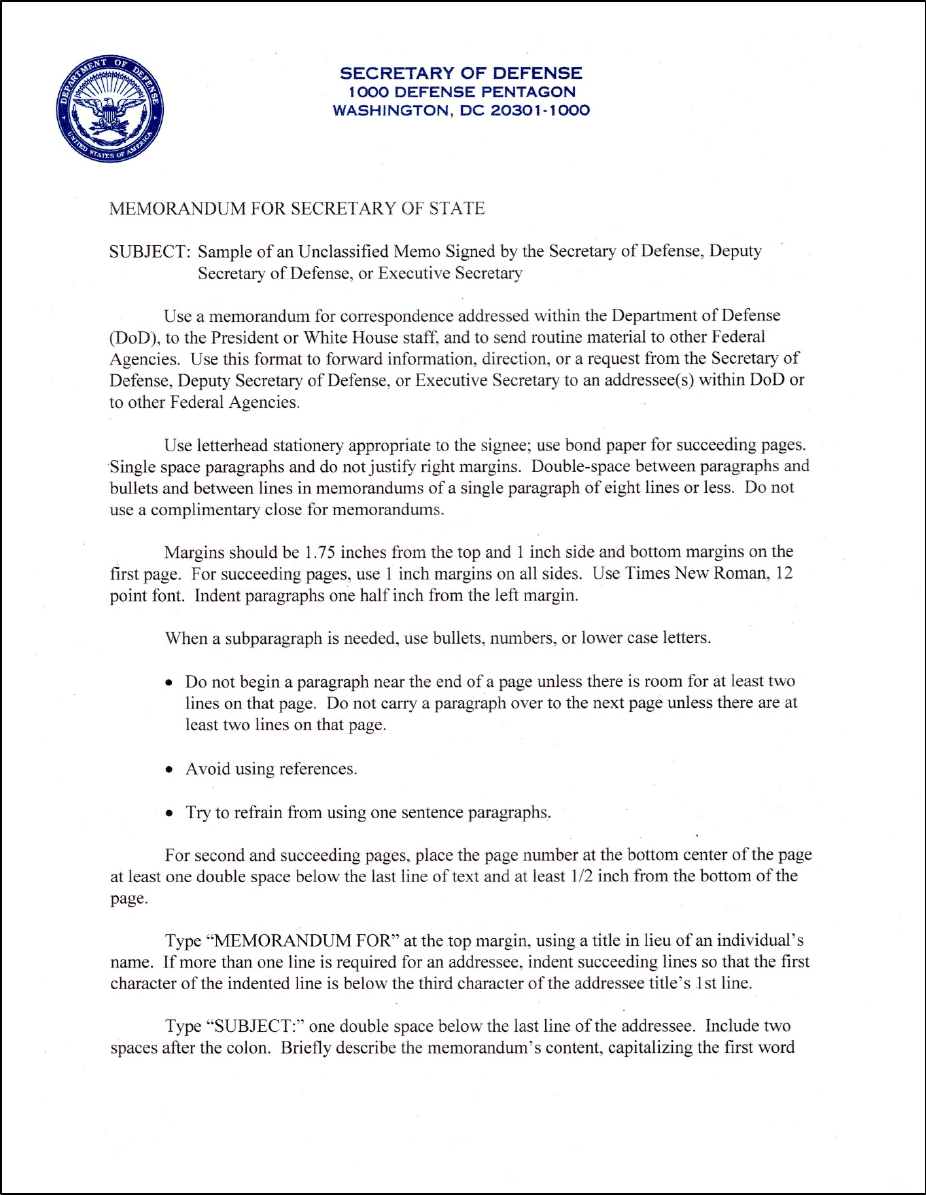
DoDM 5110.04, Volume 1, June 16, 2020
SECTION 7: MEMORANDA 55
Figure 1. Sample Standard Unclassified Memorandum
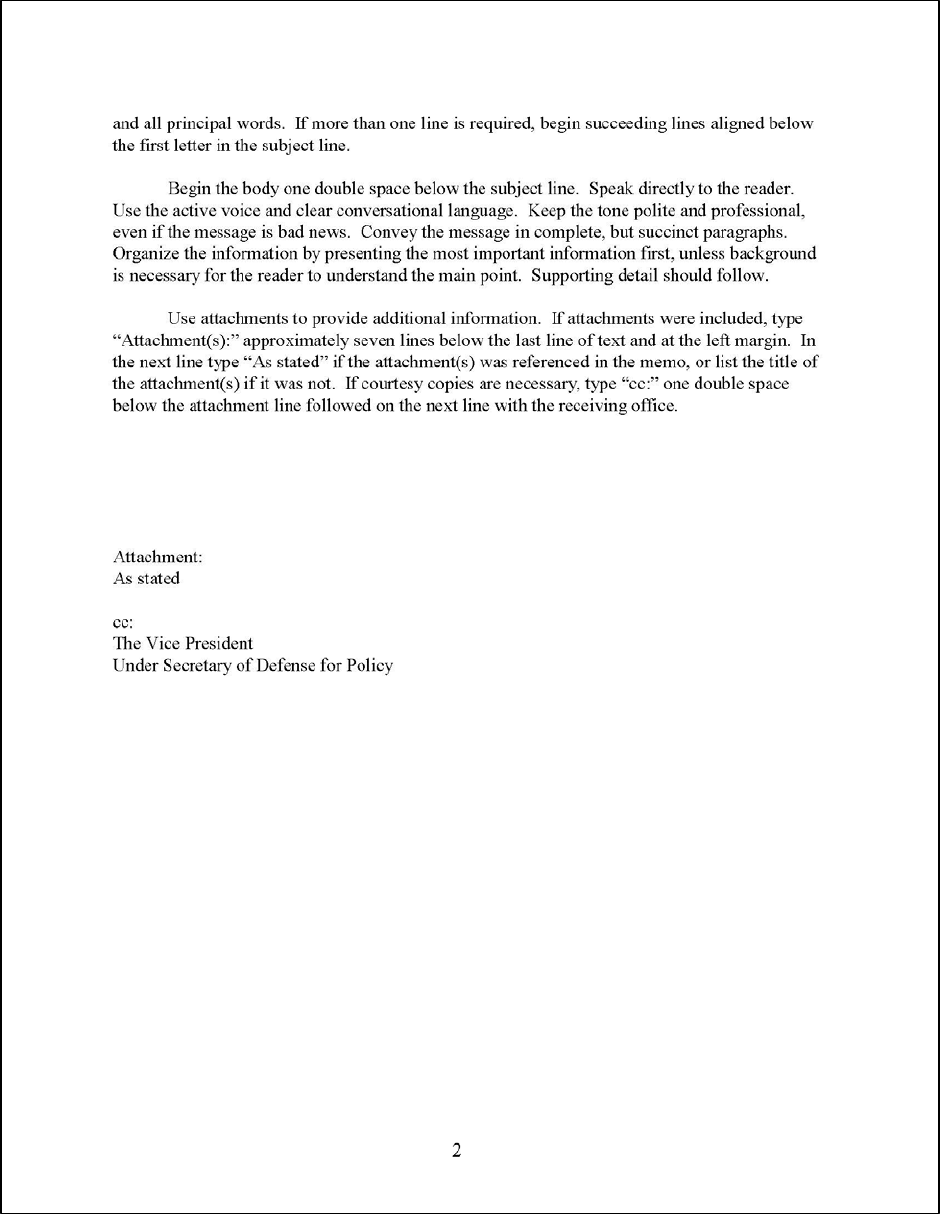
DoDM 5110.04, Volume 1, June 16, 2020
SECTION 7: MEMORANDA 56
Figure 1. Sample Standard Unclassified Memorandum, Continued
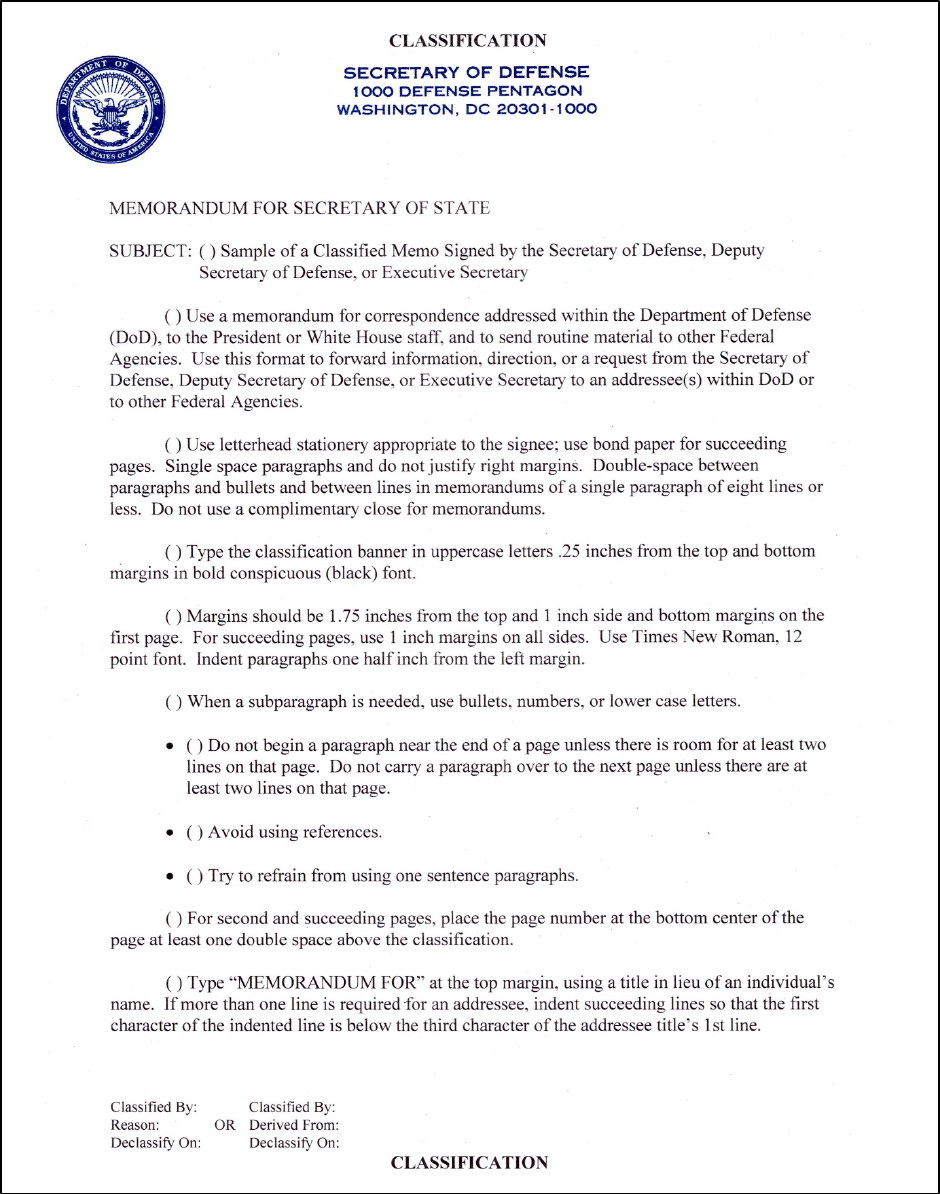
DoDM 5110.04, Volume 1, June 16, 2020
SECTION 7: MEMORANDA 57
Figure 2. Sample Standard Classified Memorandum
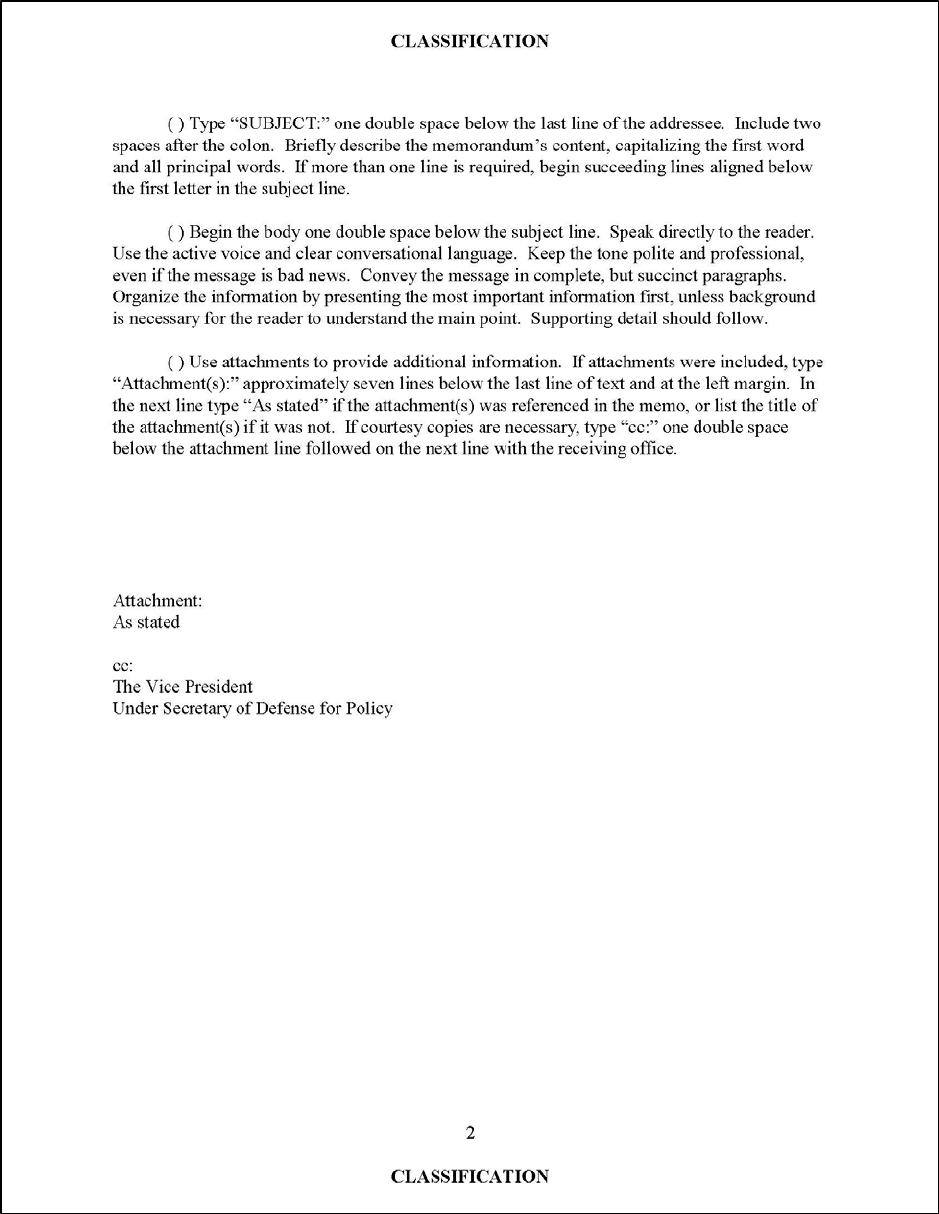
DoDM 5110.04, Volume 1, June 16, 2020
SECTION 7: MEMORANDA 58
Figure 2. Sample Standard Classified Memorandum, Continued
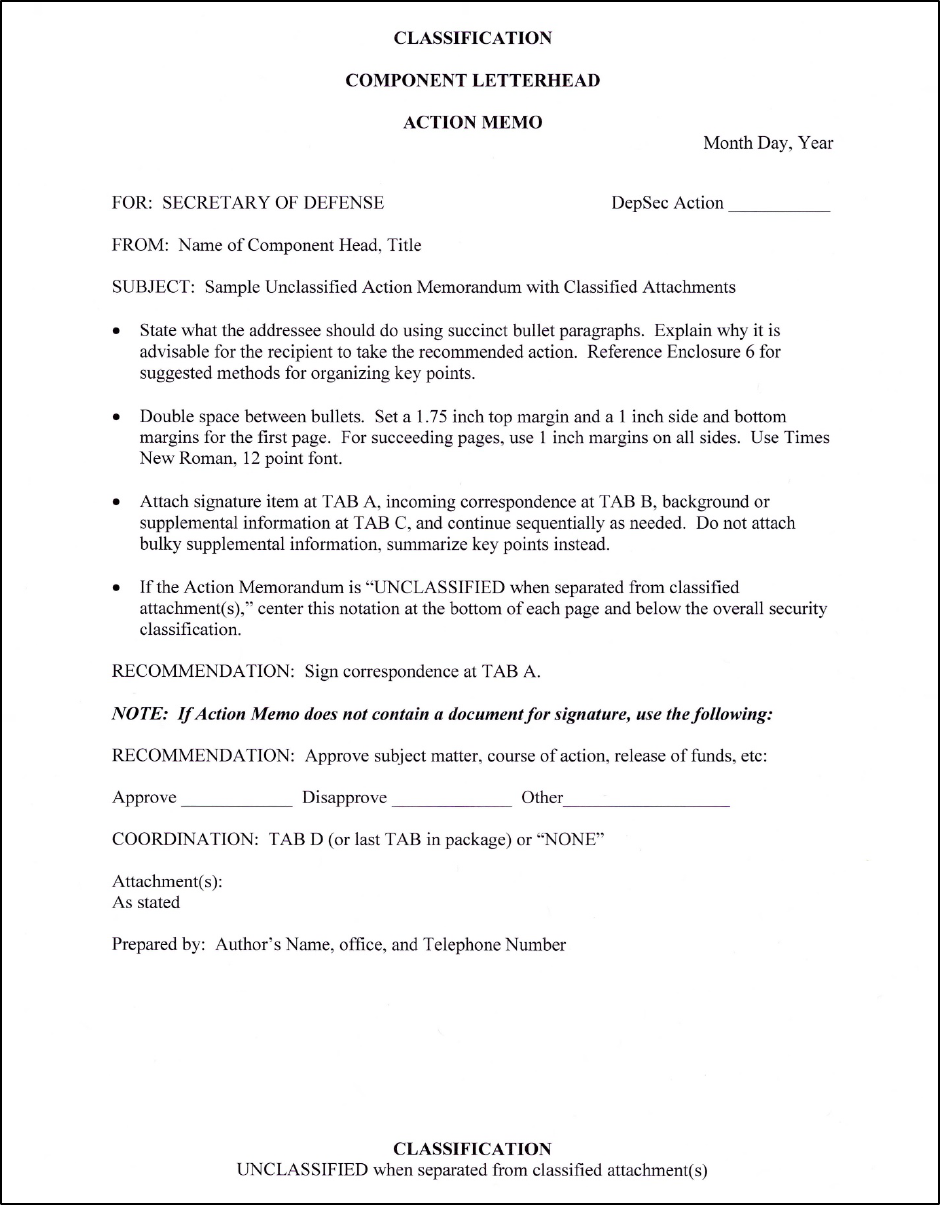
DoDM 5110.04, Volume 1, June 16, 2020
SECTION 7: MEMORANDA 59
Figure 3. Sample Action Memorandum
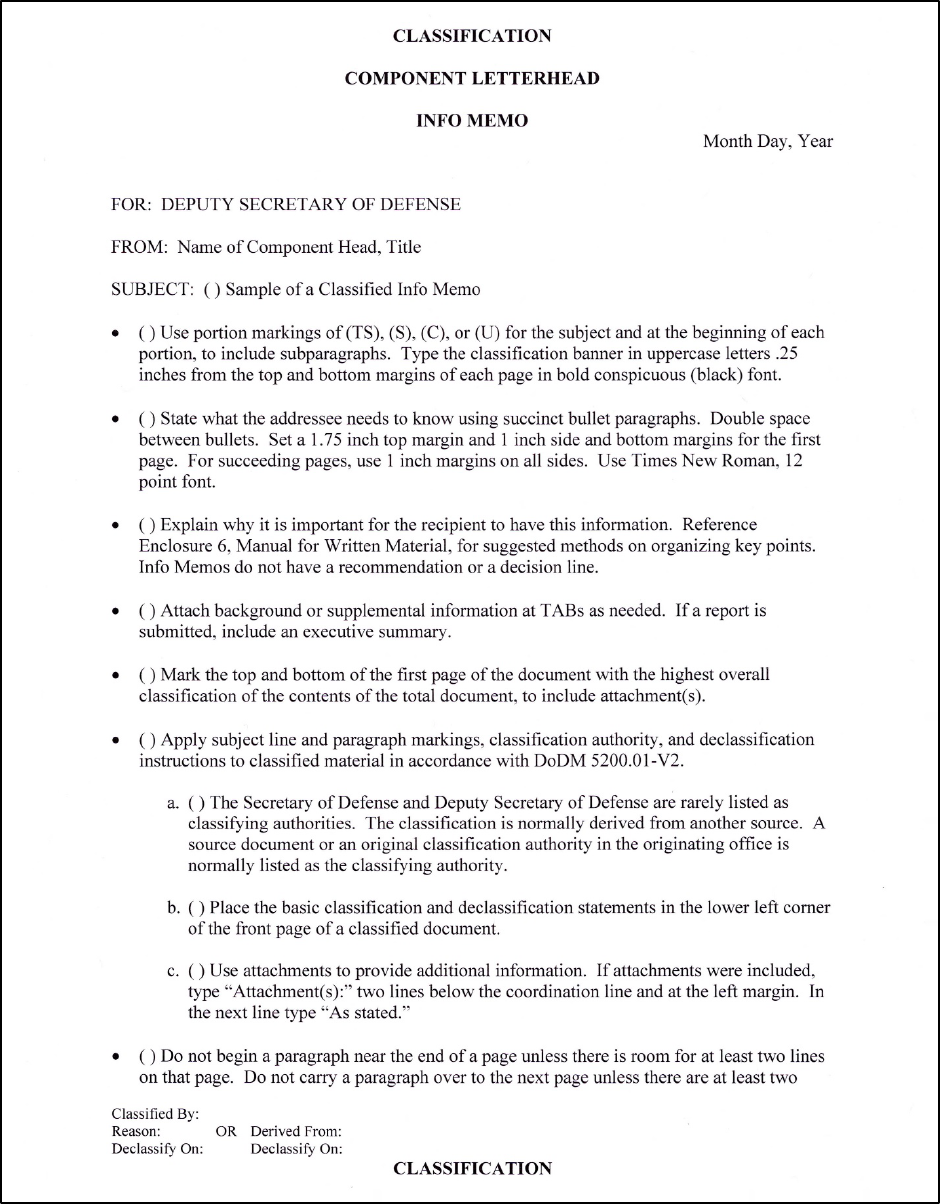
DoDM 5110.04, Volume 1, June 16, 2020
SECTION 7: MEMORANDA 60
Figure 4. Sample Classified Info Memorandum

DoDM 5110.04, Volume 1, June 16, 2020
SECTION 7: MEMORANDA 61
Figure 4. Sample Classified Info Memorandum, Continued
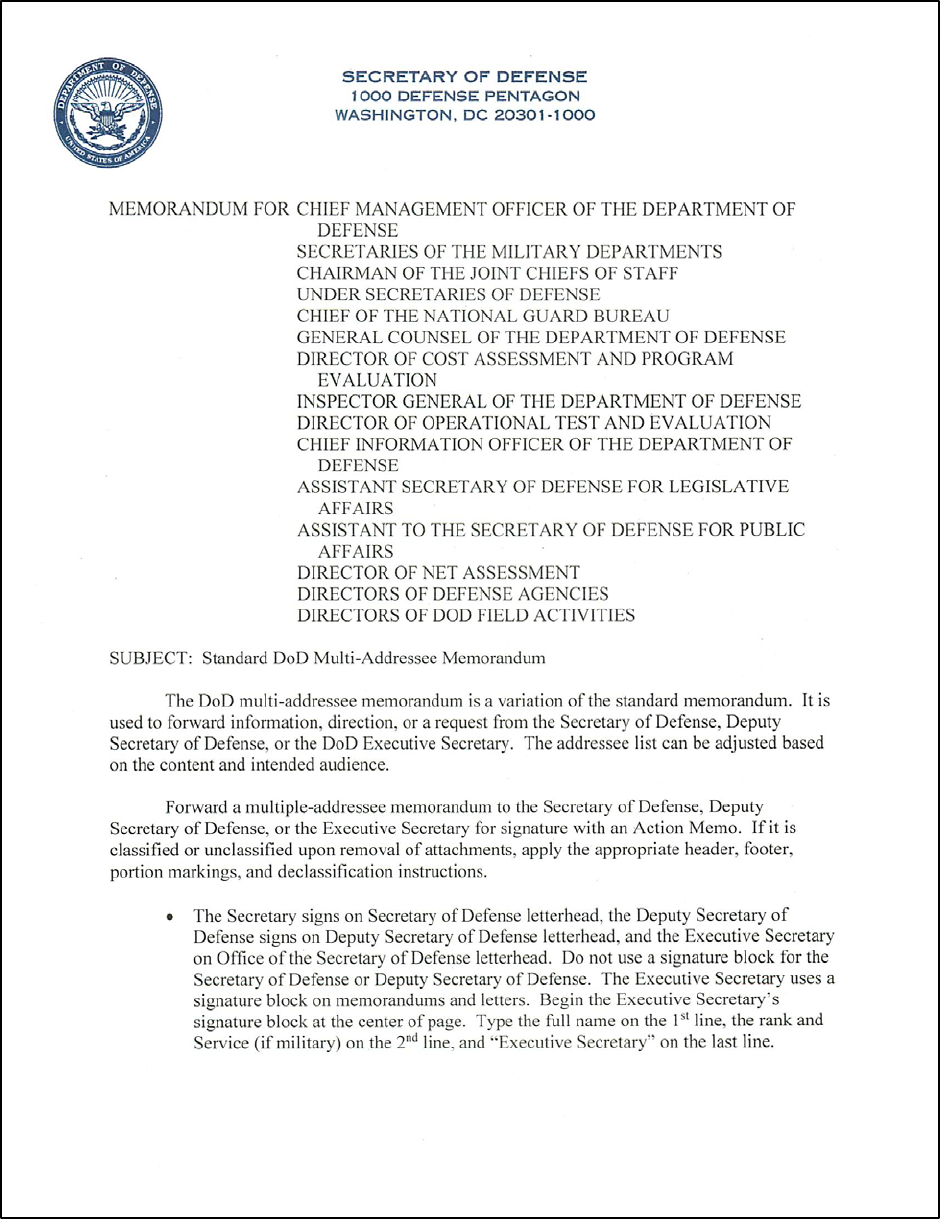
DoDM 5110.04, Volume 1, June 16, 2020
SECTION 7: MEMORANDA 62
Figure 5. Sample Multi-Addressee Memorandum
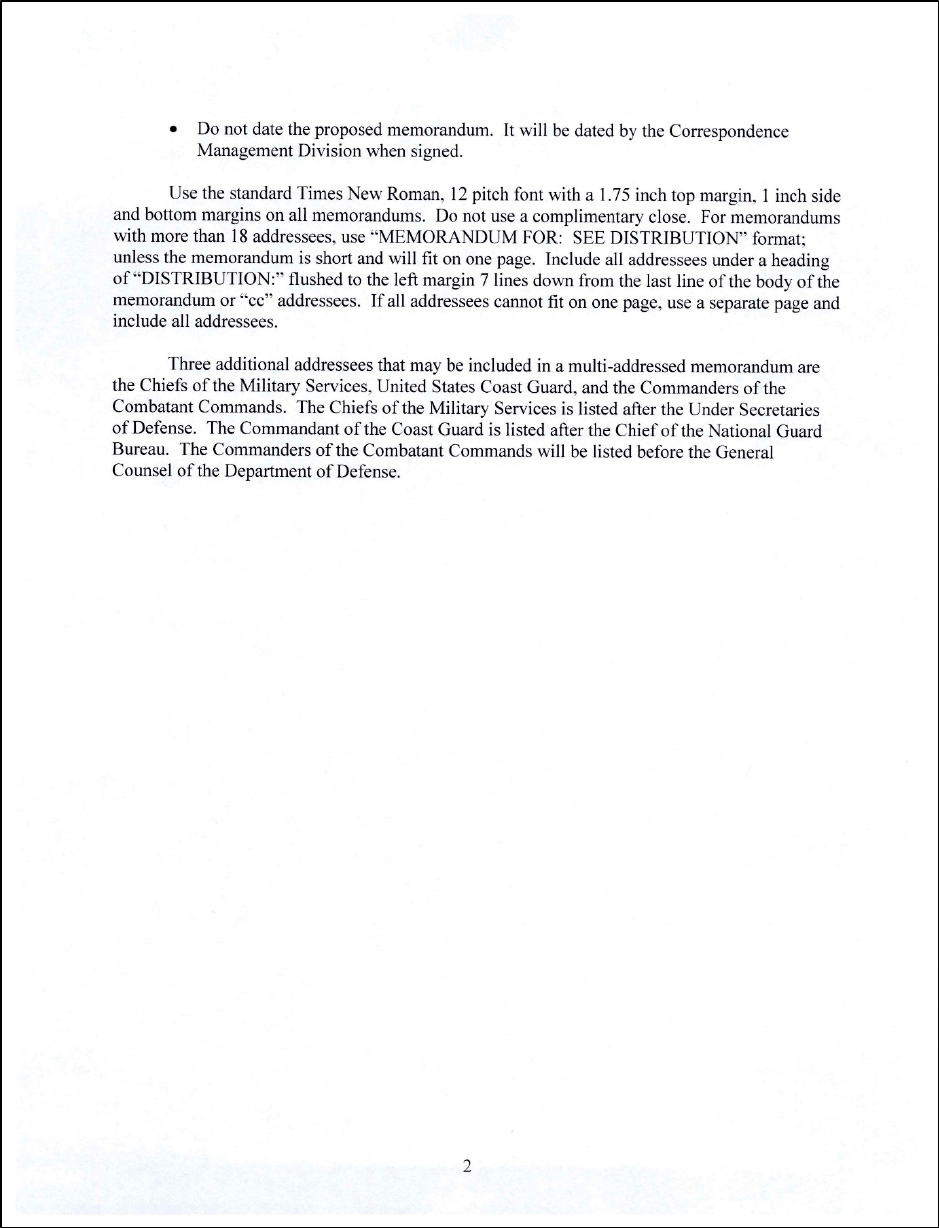
DoDM 5110.04, Volume 1, June 16, 2020
SECTION 7: MEMORANDA 63
Figure 5. Sample Multi-Addressee Memorandum, Continued

DoDM 5110.04, Volume 1, June 16, 2020
SECTION 7: MEMORANDA 64
Figure 6. Sample Multi-Addressee Memorandum with Combatant Commanders
DoDM 5110.04, Volume 1, June 16, 2020
SECTION 8: LETTERS 65
SECTION 8: LETTERS
8.1. WHEN TO USE A LETTER.
a. Use official letters for correspondence with individuals outside the U.S. Government and
for formal correspondence with officials of other federal agencies.
b. Use personal letters for SecDef and DepSecDef communications that require a personal
touch (e.g., thanks, congratulations, condolences, and acknowledgments).
c. SecDef and DepSecDef communications with foreign government officials require both a
letter and an automated message handling system (AMHS) message for electronic transmission.
See Section 10 for more detailed procedures.
8.2. PREPARING OFFICIAL LETTERS.
a. Stationery.
See Figure 7 at the end of this section for a sample official letter. Prepare official letters on
8.5 by 11-inch letterhead as indicated in Paragraphs 8.2.a.(1) through (4). Use bond paper for
second and succeeding pages.
(1) SecDef.
SecDef letterhead.
(2) DepSecDef.
DepSecDef letterhead.
(3) ExecSec or Special Assistant(s) to the SecDef or DepSecDef.
OSD letterhead.
(4) OSD and DoD Component Heads.
Appropriate Component letterhead.
b. Margins.
Use a 1.75-inch top margin and 1-inch side and bottom margins on the first page. The top
margin may be adjusted, if not printed on letterhead (e.g., letters with multiple co-signers), up to
1 inch. For succeeding pages, use 1-inch margins on all sides. If the letter contains less than 11
lines, side margins may be increased to 2 inches. Do not justify right margins.
DoDM 5110.04, Volume 1, June 16, 2020
SECTION 8: LETTERS 66
c. Font.
Use 12-point Times New Roman.
d. Spacing.
Single space within a paragraph for all correspondence of two or more paragraphs. Always
double space between paragraphs and bullets, and between lines in correspondence of a single
paragraph of eight lines or less.
e. Indentation.
Indent paragraphs .5 inch from the left margin; indent subparagraphs an additional .5 inch.
f. Paragraphing.
Use bullets, numbers, or lower-case letters for subparagraphs. Do not begin a paragraph near
the end of a page unless there is room for at least two lines on that page. Do not carry a
paragraph over to the next page unless there are at least two lines on that page. Do not use one-
sentence paragraphs.
g. Page Numbering.
Do not number the first page. For second and succeeding pages, place the page number(s) at
the bottom center of the page at least a double-space (one blank line) below the last line of text
and 1 inch from the bottom of the page.
h. Date.
Insert the date a double-space below the last line in the letterhead or department shield,
ending at the right margin. Use month, day, year, showing day and year in numerals. Omit the
date on letters for SecDef, DepSecDef, or ExecSec signature.
i. Address.
Place the recipient’s address a double space below the date, aligned with the left margin. See
Volume 2 of this manual for proper forms of address for officials in the public and private
sectors and Service members.
(1) State Names.
Use the two-letter abbreviations with no punctuation for States. See Volume 2 of this
manual for a list of State abbreviations.
(2) ZIP Code.
Use ZIP+4 codes when available. Place ZIP+4 codes two spaces after the two-letter State
identifier. See Section 1 of Volume 2 of this manual for a list of ZIP+4 codes for OSD
addresses.

DoDM 5110.04, Volume 1, June 16, 2020
SECTION 8: LETTERS 67
(3) Envelope Address.
Type the mailing address aligned left and centered on the envelope. A rubber stamp may
be used for the return address; do not handprint or use a rubber stamp for the recipient’s address
on envelopes for outgoing official mail. Use the standard two-letter State abbreviation with the
ZIP +4 code. Recipient’s address line cannot exceed five lines.
j. Attention Line.
When an attention line is appropriate, type “Attention:” on the line above the street or box
number as shown in Table 21.
Table 21. Sample Attention Line in a Letter
k. Salutation.
(1) Use formal salutations on correspondence for SecDef or DepSecDef signature unless
precedent or known personal relationships make a more familiar greeting more appropriate. See
Volume 2 of 5110.04 for appropriate salutations for public and private officials and Service
members.
(2) Follow formal salutations with a colon and informal or familiar ones with a comma.
l. Body.
(1) Introduction.
(a) Begin the introduction a double space below the salutation. Be brief; no more
than a quarter of the page or five lines.
(b) Provide a framework for the reader by referencing their correspondence or the
last contact. When responding on behalf of the SecDef or the DepSecDef, state: “This is in
reply to your letter to Secretary (name) (or Deputy Secretary (name)) regarding....” Do not say
“The Secretary (or Deputy Secretary) has asked that I respond to your letter,” unless you have
specific instructions to that effect.
(c) Address the reader’s top one or two concerns.
(2) Substance.
(a) Try to restrict your subsequent paragraphs to 10 or 15 lines.
DoDM 5110.04, Volume 1, June 16, 2020
SECTION 8: LETTERS 68
(b) Provide details about the reader’s most important concerns and address secondary
ones. Be concise and targeted, stating realistic suspense dates where applicable.
(c) Use problem-solution, compare and contrast, chronological, or most-to-least
important order, depending on your message.
(3) Quotations.
(a) Short Quotations.
Run direct quotations of less than two lines into the text, using both double and single
quotation marks as necessary. For example: The regulation clearly states, “...ambiguous
references such as ‘herein,’ ‘above,’ ‘below,’ and the like must not be used.”
(b) Long Quotations.
Block quotations of more than two lines .5 inch from the left and right margins of the
text, omitting quotation marks.
m. Complimentary Close.
(1) Type the complementary close, followed by a comma, a double space below the last
paragraph, beginning at the center of the page.
(2) Use the closing “Respectfully yours,” in addressing the President and “Sincerely,”
for all others. See the examples in Volume 2 of this manual.
(3) The current Administration may elect to omit or use complementary closes from the
previous guidance. Use the style from the Immediate Front Offices of the SecDef and
DepSecDef if it contradicts this volume.
n. Signature Block.
(1) All Letters.
(a) Leave out the signature block on correspondence for SecDef or DepSecDef
signature.
(b) For other signers, type the name of the signer in uppercase and lowercase leaving
four blank lines below and aligning it with the complimentary close. Type the signer’s title in
uppercase and lowercase on the next line below and aligned with the name. Indent second and
succeeding lines two spaces. The title of the signer may be omitted if it is reflected in the
letterhead.
(c) The signer’s name and title may be stamped below the written signature.
(2) Dual Signature Letters.
As shown in Table 16:

DoDM 5110.04, Volume 1, June 16, 2020
SECTION 8: LETTERS 69
(a) Place on bond paper with no letterhead.
(b) When the SecDef or the DepSecDef and the head of another agency sign
correspondence, place the signature blocks side by side, leaving four blank lines below the last
line of text.
1. Type the names in uppercase and lowercase with that of the non-DoD official
aligned at the left margin and the SecDef or the DepSecDef beginning at the center of the page.
2. Type titles of both officials in title case aligned under their names.
(c) When officials from two or more offices will sign correspondence, place the
signature block of the official from the originating office on the right side of the page. Place
additional signature blocks to the left and below that of the originator.
o. Enclosures.
Use enclosures to provide information in addition to a letter. Type “Enclosure:” or
“Enclosures:” double-spaced below the signature block and at the left margin as shown in Table
22. For enclosures:
(1) Identified in the Text.
Type “As stated” at the left margin on the next line.
(2) Not Identified in the Text.
Type “Enclosure:” or “Enclosures:” double-spaced below the signature block and at the
left margin. On the next line, list each enclosure on a separate line, by title. Number all
enclosures when there is more than one.

DoDM 5110.04, Volume 1, June 16, 2020
SECTION 8: LETTERS 70
Table 22. Listing Enclosures
When a single enclosure is identified in the text:
Enclosure:
As stated
When multiple enclosures are identified in the text:
Enclosures:
As stated
When enclosure(s) are not mentioned in the text:
Enclosures:
1. Seating Chart
2. List of Attendees
p. Material Under Separate Cover.
When referring to material sent under separate cover, type “Separate cover:” aligned at the
left margin and double-spaced below the last line (e.g., signature block or enclosures). On the
next line, list the items as shown in Table 23 even though they are identified in the text. Always
send a copy of the letter with the material sent under separate cover.
Table 23. Sample List of Material Under Separate Cover in a Letter
Enclosures:
As stated
Separate Cover:
Annual DoD Report
q. Courtesy Copies.
As shown in Table 24, when the letter is being sent to people other than the addressee:
(1) Type “cc:” aligned at the left margin and double spaced below the signature block or
any other notation.
(2) Below “cc:” list the recipients, one below the other, single-spaced and beginning at
the left margin. Use title case.

DoDM 5110.04, Volume 1, June 16, 2020
SECTION 8: LETTERS 71
(3) For DoD-internal courtesy copy recipients, place recipients in the order they would
appear in a DoD standard multiple-addressee memorandum listing in accordance with the
February 20, 2020 DAOP OCMO Memorandum. Alphabetical listings may also be used.
(4) When the courtesy copy recipient name or title extends to succeeding lines, indent
the second line two spaces so that the first character of the second line begins beneath the third
character of the line above. Align third and subsequent lines for a given recipient below the first
character of the second line; do not indent third and subsequent lines further.
Table 24. Sample Courtesy Copy Listings in Letters
Multiple courtesy copies by name
cc:
The Honorable Jane Q. Public
The Honorable John Q. Smith
Courtesy copy with title specified
cc:
The Honorable Jane Q. Public
Ranking Member
Multiple courtesy copies with title specified
on one official
cc:
The Honorable Jane Q. Public
Ranking Member
The Honorable Jim Q. Smith
Multiple courtesy copies with titles specified
cc:
The Honorable John Q. Public
Secretary of the Army
The Honorable Jane Q. Smith
Under Secretary of Defense (Comptroller)/
Chief Financial Officer, Department
of Defense
r. Security Classification Markings.
In accordance with Volume 2 of DoD Manual 5200.01 and Paragraph 7.2.u.
8.3. PACKAGING A LETTER FOR DELIVERY.
Prepare a package to forward letters for SecDef or DepSecDef signature using an action
memorandum as the cover or forwarding document, as instructed in Paragraph 7.3. See Section
4 for details on preparing and packaging White House correspondence and Section 5 for
congressional correspondence.
DoDM 5110.04, Volume 1, June 16, 2020
SECTION 8: LETTERS 72
8.4. SUBMITTING A LETTER FOR SIGNATURE.
Submit letter packages to CMD for control and forwarding through the ExecSec to either the
SecDef or the DepSecDef. Ensure final documents are uploaded in CATMS or, if self-
generated, email the latest documents to [email protected].
8.5. PREPARING PERSONAL LETTERS FOR SECDEF AND DEPSECDEF
SIGNATURE.
Use the personal letter for SecDef and DepSecDef communications that require a personal touch
(e.g., thanks, congratulations, condolences, and acknowledgments). A personal letter is not used
for official and policy-related matters. To prepare a personal letter, use the guidelines for
preparing an official letter in Paragraph 8.2, with these exceptions:
a. Stationery and Envelopes.
(1) SecDef and DepSecDef personal letter stationery and envelopes are controlled.
Submit letters for SecDef, DepSecDef, or ExecSec signature using an action memorandum
prepared in accordance with Paragraph 7.3. Include the letter for signature, in final form, on 8.5
by 11-inch letterhead appropriate to the requested signing official. The SecDef and the
DepSecDef immediate offices will prepare the letter on SecDef or DepSecDef personal letter
stationery as deemed appropriate. Ensure final electrons are in CATMS or, if self-generated,
email the latest electrons to whs.pentagon.esd.list.e[email protected].
(2) The ExecSec reviews SecDef personal letters in final form, which includes an
editorial review, printing on SecDef personal letter stationery, and envelope preparation. The
DepSecDef office processes DepSecDef personal letters in final form.
b. Subject and Attention Lines.
Do not use on personal letters.
c. Date.
Omit the date. CMD will stamp the date on the second line below the letterhead, ending at
the right margin, on the day the letter is signed and dispatched.
d. Forms of Address.
The proper address form, salutation, and complimentary close are determined by social and
official custom. See Volume 2 of this manual for a list of proper forms of address for sending
letters to the White House; Congress; Executive departments; foreign diplomatic missions to the
United States; international organizations; foreign chiefs of state, heads of government, and
cabinet officers; State and local governments; Military Services; and private citizens.

DoDM 5110.04, Volume 1, June 16, 2020
SECTION 8: LETTERS 73
(1) Do not abbreviate the title preceding full names in an address, except “Mr.,” “Mrs.,”
or “Dr.” Spell out titles such as “His Excellency,” “The Honorable,” or “The Right Honorable”
in an address for balance and appearance.
(2) Enter address lines flush with the left margin, except when addressing a personal
letter to a foreign chief of state, head of government, or cabinet minister, as shown in Table 25.
In that case:
(a) Enter “His or Her Excellency” (unless otherwise entitled to “His or Her
Highness,” “The Right Honorable,” or other title specified in Volume 2 of this manual) as the
first line of the address, flush with the left margin.
(b) Indent the official’s name on the second line, three spaces from the left margin.
Indent the title on the third line, five spaces from the left margin.
(c) Enter the official mailing address (post office box or street address) beginning on
the fourth line, flush with the left margin. Indent second and succeeding lines three spaces from
the left margin.
(d) Consult the Office of the Under Secretary of Defense for Policy CCMO for any
questions regarding the titles, forms of address, or mailing addresses of foreign officials.
Table 25. Addressing a Foreign Chief of State, Head of Government, or Cabinet Minister
Addressee
Address On Letter and Envelope
Salutation and Complimentary
Close
President
His/Her Excellency (full name)
(title)
(address)
Dear Mr./Madam President:
Sincerely,
Prime Minister
His/Her Excellency (full name)
Prime Minister of (country)
(address)
Dear Mr./Madam Prime Minister:
Sincerely,
Cabinet Minister
His/Her Excellency (full name)
(title)
(department)
(address)
Dear Mr./Madam Minister:
Sincerely,
King/Queen
His/Her Majesty (full name)
King/Queen of (country)
(address)
Your Majesty:
Sincerely,
Prince/Princess
His/Her Highness (full name)
(title)
(address)
Your Highness:
Sincerely,
Governor General
His/Her Excellency (full name)
Governor General of (country)
(address)
Dear Governor General:
Sincerely,
DoDM 5110.04, Volume 1, June 16, 2020
SECTION 8: LETTERS 74
e. Envelope Address.
(1) Because personal letters will be delivered through a postal system, obtaining the
proper address is required. If the letter is returned with an incorrect or incomplete address,
valuable time will be lost in getting the correspondence to its intended destination.
(2) Always use the complete address on envelopes. Type the mailing address block
style, single-spaced in Microsoft Word, for proper placement on the envelope. Do not use
punctuation except with common abbreviations. Indent second and succeeding lines three
spaces. Do not handprint or use a rubber stamp for the recipient’s address on envelopes for
outgoing personal letters. If a name, title, or address does not fit on the envelope, the font size
may be reduced to 11 point. The return address is pre-printed on the back of the envelopes.
(a) State Names.
Use the standard two-letter postal abbreviations. See Table 2 of Volume 2 of this
manual for two-letter U.S. State and Canadian Province abbreviations.
(b) ZIP Code.
Use ZIP+4 codes when available. Place ZIP+4 codes two spaces after the two-letter
State identifier. See Table 1 of Volume 2 of this manual for a list of ZIP+4 codes for OSD
addresses.
(c) Listing of Directional Abbreviations, Frequently Used Street Designations, and
Secondary Address Unit Indicators.
See Volume 2 of this manual for further guidance.
(d) Official Designations for Countries and Capitals.
Use the long-form country and capital names in personal letters for SecDef and
DepSecDef signature. Refer to the U.S. Department of State’s “Independent States in the
World” for a list of the official short-form and long-form country and capital names, available at
https://www.state.gov/s/inr/rls/4250.htm.
(e) Hand Delivered Personal Letters to Foreign SecDef and DepSecDef Counterparts.
For SecDef and DepSecDef personal letters going to a counterpart or other dignitary
in a foreign country that will be hand-delivered by the U.S. Defense Attaché, prepare an
additional SecDef or DepSecDef envelope addressed to the U.S. Defense Attaché for that
country. If there is no resident Defense Attaché, address the envelope to the diplomatically
accredited attaché.
f. Signature Block.
A typed signature block is not used on personal letters for SecDef and DepSecDef signature.
DoDM 5110.04, Volume 1, June 16, 2020
SECTION 8: LETTERS 75
g. Courtesy Copies.
A cc: line is not appropriate on a personal letter.
h. Special Handling Instructions.
When submitting proposed personal letters for SecDef or DepSecDef signature, provide any
special handling or mailing instructions to expedite out-processing by CMD, such as: “Mail
letter unfolded as the recipient will frame the letter.”
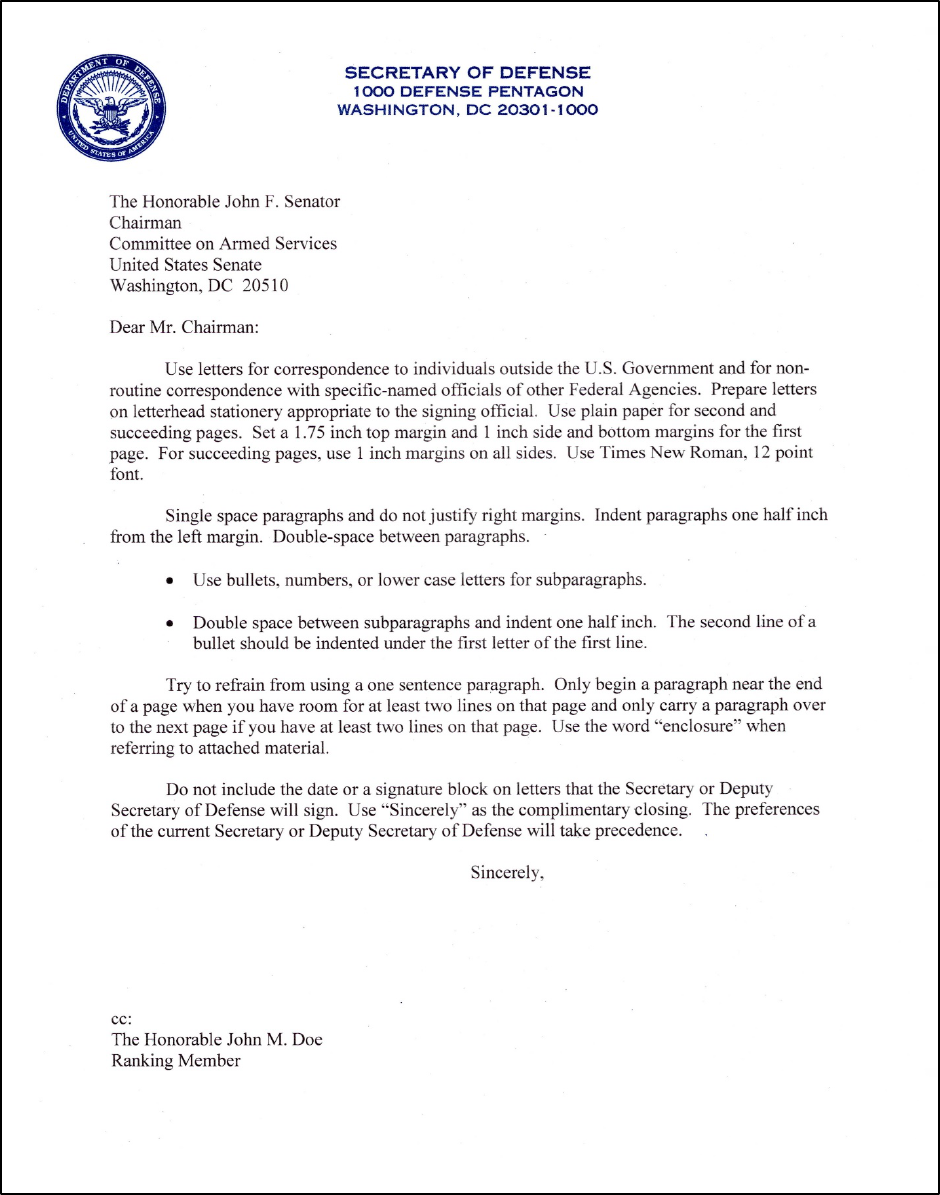
DoDM 5110.04, Volume 1, June 16, 2020
SECTION 8: LETTERS 76
Figure 7. Sample Official Letter
DoDM 5110.04, Volume 1, June 16, 2020
SECTION 9: CATMS 77
SECTION 9: CATMS
9.1. GENERAL.
SecDef and DepSecDef incoming taskers and resulting staff packages are processed through
CATMS in accordance with DoDI 5045.01. CATMS allows users to control correspondence;
assign tasks associated with that correspondence; request coordination on documents produced in
response to taskers; and maintain version control on edits and concurrences in shared libraries.
Correspondence can be controlled on both the Non-classified Internet Protocol Router Network
and the SECRET Internet Protocol Router Network CATMS.
9.2. USING CATMS TO TASK AND COORDINATE CORRESPONDENCE.
CATMS is used for:
a. Controlling correspondence incoming and within the DoD. Its SharePoint libraries serve
as a resource for retrieving documents controlled in the system and the data entry on controlled
documents can be searched using a variety of views and reports.
b. Tasking controlled correspondence for a variety of response types. Taskers are a tool to
track the suspense on responding to the controlled document and further assign work products
for coordination.
c. Reporting unclassified metrics and suspense dates (e.g., the Stoplight Report).
9.3. PROCESSING CORRESPONDENCE IN CATMS.
a. When a document is received and addressed to a department official, the following actions
are taken in CATMS:
(1) The letter or memorandum is controlled in CATMS and provided an OSD control
number as stated in Paragraph 3.1.b. of this volume.
(2) The letter or memorandum is tasked to an OPR with the request type, response type,
suspense date, and any required coordination.
(3) The OPR drafts a response and uploads it to a tasker “Supporting Documents”
section and assigns it to offices of coordinating responsibility (OCRs) for coordination.
(4) The OCRs provide concurrences, nonconcurrences, and any edits in document form,
upload them to the tasker “Supporting Documents” section and complete the assignments in the
tasker.
(5) The OPR adjudicates any edits and routes the draft for signature.
DoDM 5110.04, Volume 1, June 16, 2020
SECTION 9: CATMS 78
(6) Upon receiving the signed document, the OPR will upload the document into the
tasker “Final Documents” section to provide copies of the final product to all OCRs.
b. Training in the processes and tools associated with controlling and tasking
correspondence using CATMS is available through the CATMS Training Resources Website at
https://whs.sp.pentagon.mil/catms/SitePages/training.aspx.
DoDM 5110.04, Volume 1, June 16, 2020
SECTION 10: COMMUNICATION WITH FOREIGN GOVERNMENT OFFICIALS 79
SECTION 10: COMMUNICATIONS WITH FOREIGN GOVERNMENT
OFFICIALS
10.1. GENERAL.
SecDef and DepSecDef communications with foreign government officials require both a letter
and transmission of an electronic message. Certain other communications are sent out by
electronic message only. The guidance in this section applies to any controlled SecDef or
DepSecDef correspondence that requires the transmission of an electronic message. The
messages are processed via AMHS.
10.2. PREPARING AND SUBMITTING ELECTRONIC MESSAGES.
The OPR must ensure the updated Microsoft Word document of the SecDef or the DepSecDef
letter or communication, once signed or approved, is uploaded in CATMS, and sent via email in
Microsoft Word format to CMD Executive Services Branch at
10.3. PROCESSING ELECTRONIC COMMUNICATIONS.
a. Before out-processing a signed SecDef or DepSecDef letter to a foreign official or other
communication intended for AMHS delivery, CMD will:
(1) Prepare the message in AMHS.
(2) Review the message. Ensure the message text is identical to the SecDef or the
DepSecDef-signed letter or communication and the message recipients are correctly listed.
(3) Send the message to SecDef Cables for release via AMHS and notify them via email
that the message is ready for release. Include a PDF of the signed original letter or
communication with the email.
b. Upon notification by CMD, SecDef Cables will review and release the message and
provide CMD with confirmation of message release.
DoDM 5110.04, Volume 1, June 16, 2020
SECTION 11: E-MAIL 80
SECTION 11: E-MAIL
11.1. GENERAL.
E-mail communication is considered official correspondence, and is a critical component of the
DoD’s day-to-day business operations. Clear and concise emails support a more efficient and
effective workforce in DoD. This section details the elements of successful email
communication and the best practices associated with achieving clarity when conducting
business through email.
11.2. GUIDELINES.
a. Choose e-mail when a message must be delivered quickly or when the information is
more easily sent digitally rather than by printed (hard) copy. E-mail also allows recipients to be
contacted as soon as they are available.
b. Subject lines should briefly and accurately describe the e-mail’s content.
c. E-mails, like any other written business communication, must be professional, courteous,
and concise. Address recipients appropriately and respectfully. Give thought to who the
recipient(s) should be, and include in the cc: line those who may require visibility or situational
awareness. Bcc’s should be used sparingly for discreet purposes.
d. State the purpose of the e-mail in the opening sentence. Placing the bottom line up front
will draw attention to what you are trying to achieve. Refer to Section 6 for drafting the body
text of a business e-mail.
e. Maintain a paragraph structure similar to letters as outlined in this manual; omit address
and signature blocks. “Dear” and “Sincerely” are generally omitted for more contextual or direct
greetings and salutations. E-mail signatures should be a professional and organizational
identification of the sender along with any applicable handling instructions and/or markings for
the specific email’s contents and attachments. E-mail signatures containing quotes, sayings,
proverbs, mottos, etc. not associated with the sender’s organization or mission are discouraged as
they generally conflict with maintaining a professional tone and can draw attention away from
the email’s purpose.
f. Senders should draft e-mails in as neutral a tone as possible. Avoid using capital letters
for emphasis. When writing and reading e-mails, to minimize any miscommunication, try not to
confer or imply anything other than a professional tone.
g. When including attachments, cite them in the text and explain their inclusion. Be aware
of any attachment size or number restrictions and use appropriate internal shared network
resources or enterprise tools when necessary. Action officers are also encouraged to use
CATMS and its built-in SharePoint libraries when staffing a package instead of relying solely on
e-mails and attachments.
DoDM 5110.04, Volume 1, June 16, 2020
SECTION 11: E-MAIL 81
h. Follow organizational guidelines on the use of e-mail to conduct official business.
11.3. CMD’S USE OF E-MAIL.
CMD will use e-mail for:
a. Distributing SecDef, DepSecDef, and ExecSec-signed multi-memos. Hard copies are not
routinely delivered.
b. Sending advance copies of SecDef, DepSecDef, and ExecSec-signed memos. These are
then followed up with hard copy delivery.
c. Receiving Component SD Form 391 requests for tasker adjustments.
d. Receiving advance copies of incoming correspondence from other U.S. Government
officials.
e. Receiving OSD tasker guidance or special instructions from the front offices of the
SecDef, DepSecDef, and ExecSec.
DoDM 5110.04, Volume 1, June 16, 2020
SECTION 12: LETTERHEAD STATIONERY 82
SECTION 12: LETTERHEAD STATIONERY
12.1. GENERAL.
This section provides guidance, procedures, and responsibilities concerning specifications for
official letterhead stationery used within the DoD, and provides for the use of computer-
generated letterhead stationery.
12.2. GUIDANCE.
a. DoD pre-printed letterhead stationery must be uniform and must contain only those
elements described in this section.
b. OSD Component, Defense Agency, and DoD Field Activity pre-printed letterhead
stationery must be uniform and must contain only those elements described in this section.
12.3. AUTHORIZATIONS.
a. Authorized Users.
(1) These officials are authorized to use DoD letterhead stationery as indicated:
(a) SecDef.
SecDef letterhead.
(b) DepSecDef.
DepSecDef letterhead.
(c) Office of the DepSecDef.
Office of the DepSecDef letterhead.
(d) Chief Management Officer of the Department of Defense.
Chief Management Officer letterhead.
(e) USDs.
USD letterhead with the appropriate USD designator below the DoD seal.
(f) ASDs.
ASD letterhead with the appropriate ASD designator below the DoD seal.
DoDM 5110.04, Volume 1, June 16, 2020
SECTION 12: LETTERHEAD STATIONERY 83
(g) Chairman of the Joint Chiefs of Staff.
Chairman’s letterhead.
(h) Secretaries of the Military Departments.
Military Secretary letterhead.
(i) OSD Component Offices.
OSD letterhead with the appropriate subordinate office designators below the DoD
seal.
(j) Offices of the USDs.
The applicable USD letterhead with the appropriate subordinate office designators
below the DoD seal.
(k) Offices of the ASDs.
The applicable ASD letterhead with the appropriate subordinate office designators
below the DoD seal.
(2) Organizations that report directly to the SecDef but do not fall under a USD or ASD
may use OSD letterhead with their organization name designation entered below the DoD seal.
(3) SecDef- and DepSecDef-chartered boards and commissions may use OSD letterhead
with their organization name designation indicated below the DoD seal.
b. Authorized Designators.
The OSD and DoD Component heads will authorize the use of letterhead for officials under
their purview, and may further authorize subordinate officials to exercise this authority for
organizations under their purview. Letterhead and designator authorization to subordinate
officials and organizations includes approval to use:
(1) Letterhead appropriate to the organization’s position within the parent organization
or Military Service.
(2) Appropriate organization designators.
(3) Commemorative seals.
(4) Organizational logos and mottos, as approved by the Component head.
DoDM 5110.04, Volume 1, June 16, 2020
SECTION 12: LETTERHEAD STATIONERY 84
12.4. PROCEDURES.
a. Preprinted Official Letterhead Stationery.
Pre-printed official letterhead stationery:
(1) Must be used for all correspondence prepared for SecDef, DepSecDef, and ExecSec
signature and for all correspondence to addressees outside the DoD.
(a) Correspondence for SecDef signature must be printed on SecDef letterhead. The
SecDef will be the only DoD official who signs correspondence printed on SecDef letterhead.
SecDef immediate office personnel issuing official correspondence will sign on OSD letterhead.
(b) Correspondence for DepSecDef signature must be printed on DepSecDef
letterhead. The DepSecDef will be the only DoD official who signs correspondence printed on
DepSecDef letterhead. DepSecDef immediate office personnel issuing official correspondence
may sign on either OSD or Office of the DepSecDef letterhead.
(c) Correspondence prepared for ExecSec signature must be printed on OSD
letterhead.
(2) Must be 8.5 by 11 inches in size and must:
(a) Be printed on approximately 20-pound, white, bond paper in blue or black ink.
Use of recycled paper is authorized and encouraged. Use of paper of similar quality is
authorized when the stated is not available. Continuation pages must be blank sheets of the same
size as the first page and of similar quality.
(b) Include the DoD seal, which must be 1 inch in diameter and 1/2 inch from the
upper left and top edges of the stationery.
(c) Carry no other decorative or distinguishing insignia, printed or otherwise.
(3) Must include the name of the principal activity (such as “Department of the Army,”
or “Defense Logistics Agency”) centered horizontally 5/8 inch from the top of the sheet and
printed in 12-point, bold Gothic or Copperplate Gothic capital letters or equivalent.
(4) Must include the name of the department, agency, office, bureau, board, commission,
administrative or technical service, or principal command centered immediately under the name
of the principal activity to which this section applies, printed in 6-point, bold Gothic or
Copperplate Gothic capital letters or equivalent.
(5) Must include the address and five-digit ZIP code number centered horizontally
beneath the name of the department, agency, office, bureau, board, commission, administrative
or technical service, or principal command printed in 6-point, bold Gothic or Copperplate Gothic
capital letters or equivalent. The bottom of the printing must be 1 and 1/16 inches from the top
of the trimmed sheet.
DoDM 5110.04, Volume 1, June 16, 2020
SECTION 12: LETTERHEAD STATIONERY 85
(6) May incorporate:
(a) The phrase “IN REPLY REFER TO,” printed in 5-point, light plate (non-bold)
Gothic or Copperplate Gothic large capital letters or equivalent.
(b) Corner markings to indicate the address area for window envelopes.
(c) Fold markings.
(d) A 1/2-point guideline, 3/4 of an inch long, placed 1 and 1/2 inches from the
bottom and 1/8 inch from the left side.
(e) Appropriate slogans, approved by the DoD Component head concerned or
designee, and printed in the bottom margin approximately 1/2 inch from the bottom edge of the
sheet.
(7) May be obtained through CCMO and administrative officer supply acquisition
channels.
b. Computer-generated Letterhead Stationery.
(1) The DoD Components may use computer-generated letterhead stationery if it
conforms to the specifications established in this section and the OSD or DoD Component head
authorizes it.
(2) Computer-generated letterhead stationery will not be used for SecDef, DepSecDef, or
ExecSec signature.
c. Envelopes.
These types of envelopes must be used for correspondence prepared for:
(1) The OSD Component heads and their subordinate organizations: envelopes with the
printed designation “Office of the Secretary of Defense.”
(2) SecDef or DepSecDef signature: envelopes with the printed designation “Secretary
of Defense” or “Deputy Secretary of Defense.”
(3) ExecSec signature: envelopes with the printed designation “Office of the Secretary
of Defense.”
(4) The Chairman of the Joint Chiefs of Staff and the Secretaries of the Military
Departments: envelopes with printed designations corresponding to their respective offices.
These officials may further authorize the use of envelopes with designations appropriate to
subordinate offices or Military Services.

DoDM 5110.04, Volume 1, June 16, 2020
SECTION 13: OFFICIAL DIGRAPHS AND TRIGRAPHS 86
SECTION 13: OFFICIAL DIGRAPHS AND TRIGRAPHS
13.1. FOR COMPONENT ASSIGNMENTS.
CMD will use the digraphs and trigraphs in Table 26 for the DoD and OSD Component heads, as
appropriate, when assigning actions in CATMS, in suspense reports, and on the SD Form 391.
Questions regarding them may be directed to CMD at whs.pentagon.esd.mbx.cmd-
Table 26. Digraphs and Trigraphs for Action or Information Component Assigned
OSD
Entities
SD
Secretary
of
Defense (Assign Action to ES)
DSD
Deputy
Secretary of Defense
COS
The Special Assistant to
the Secretary and Deputy Secretary of Defense
MAS
Military Assistant to the Secretary of Defense
MAD
Military Assistant to the Deputy Secretary of Defense
COS
Chief of Staff
ES
Executive Secretary of the Department of Defense
ESR
Executive Secretariat Rear
ESW
Executive Secretary White House Actions
PRO
Protocol
SDS
Secretary of Defense Scheduling
DS
Deputy Secretary of Defense Scheduling
TNT
Transition Team
USA
Under Secretary of Defense for Acquisition and Sustainment
URE
Under Secretary of Defense for Research and Engineering
USP
Under Secretary of Defense for Policy
USC
Under Secretary of Defense (Comptroller)/Chief Financial Officer
UPR
Under Secretary of Defense for Personnel and Readiness
USI
Under Secretary of Defense for Intelligence and Security
CMO
Chief Management Officer
CIO
DoD Chief Information Officer
LA
Assistant Secretary of Defense for Legislative Affairs
PA
Assistant to the Secretary of Defense for Public Affairs
GC
General Counsel of the Department of Defense
OTE
Director of Operational Test and Evaluation
CAP
Director, Cost Assessment and Program Evaluation
IG
Inspector General of the Department of Defense
NA
Director of Net Assessment
Military Departments
SA
Secretary of the Army
SAF
Secretary of the Air Force
SN
Secretary of the Navy

DoDM 5110.04, Volume 1, June 16, 2020
SECTION 13: OFFICIAL DIGRAPHS AND TRIGRAPHS 87
Table 26. Digraphs and Trigraphs for Action or Information Agency Assigned, Continued
Joint Chiefs of Staff
(Listed in Order of Precedence)
JCS
Chairman of the Joint Chiefs of
Staff
DJS
Director, Joint Staff
Defense Agencies
(Listed in Alphabetical Order)
ARP
Defense Advanced Research Projects Agency
CAA
Defense Contract Audit Agency
CMA
Defense Contract Management Agency
DCM
Defense Commissary Agency
DFS
Defense Finance and Accounting Service
DHA
Defense Health Agency
DIA
Defense Intelligence Agency
DLA
Defense Logistics Agency
DLSA
Defense Legal Services Agency
DSA
Defense Information Systems Agency
DPAA
Defense POW/MIA Accounting Agency
DSC
Defense Security Cooperation Agency
DSS
Defense Counterintelligence and Security Agency
DTR
Defense Threat Reduction Agency
MDA
Missile Defense Agency
NGA
National Geospatial-Intelligence Agency
NRO
National Reconnaissance Office
NSA
National Security Agency/Central Security Service
PPA
Pentagon Force Protection Agency
SDA
Space Development Agency
Field Activities
(Listed in Alphabetical Order)
DMA
Defense Media Activity
DTIC
Defense Technical Information Center
DTSA
Defense Technology Security Administration
DODEA
DoD Education Activity
HRA
DoD Human Resources Activity
TRMC
DoD Test Resource Management Center
OEA
Office of Economic Adjustment
WHS
Washington Headquarters Services
Other Activities
AAE
Army-Air Force Exchange Service
CAB
Cables
CMD
Correspondence Management Division
DBB
Defense Business Board
DPR
Defense Performance Review
IGA
Special Inspector General Afghanistan
IGI
Special Inspector General Iraq
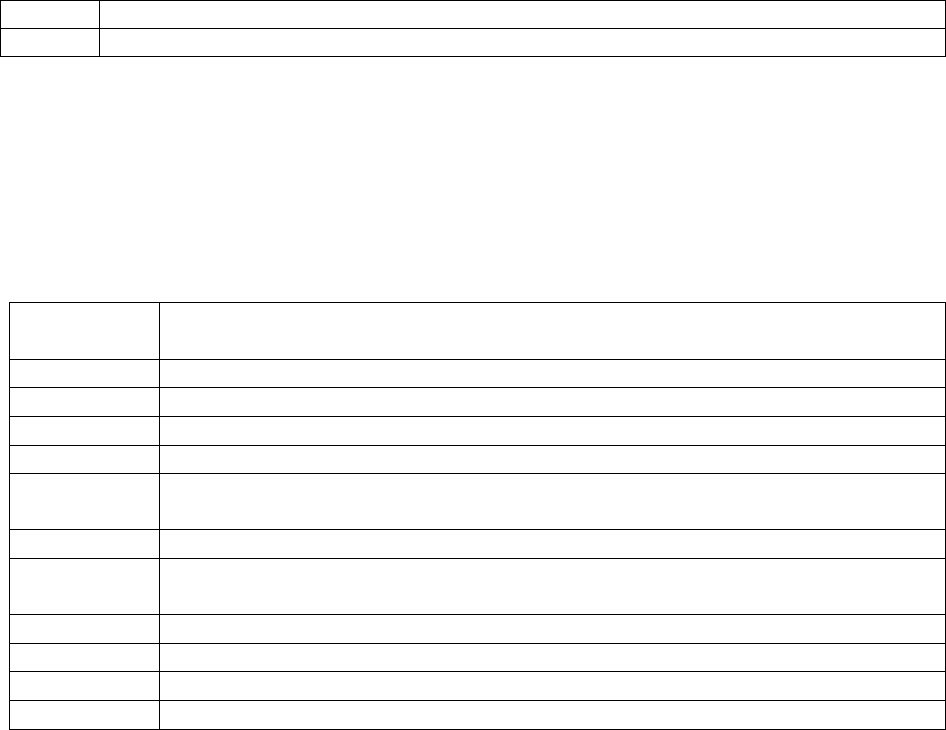
DoDM 5110.04, Volume 1, June 16, 2020
SECTION 13: OFFICIAL DIGRAPHS AND TRIGRAPHS 88
Table 26. Digraphs and Trigraphs for Action or Information Agency Assigned, Continued
NGB
Chief, National Guard Bureau
WHL
White House Liaison
13.2. FOR ACTION REQUIRED.
CMD must use the digraphs and trigraphs in Table 27 for actions required when assigning
actions in CATMS, in suspense reports, and on the SD Form 391. Questions regarding them
may be directed to CMD at whs.pentagon.esd.mbx.cmd-correspondence@mail.mil.
Table 27: Digraphs and Trigraphs for Action Required
Digraph/
Action Required (Listed in
Trigraph
Priority Order)
ASN
Answer Note from the Secretary of Defense
PRS
Prepare Reply for Secretary of Defense Signature
ADN
Answer Note from the Deputy Secretary of Defense
PRD
Prepare Reply for Deputy Secretary of Defense Signature
AMN
Answer Note
of Defense
from the Military Assistant to the Secretary or Deputy Secretary
PRE
Prepare Reply for Executive Secretary Signature
C&R
Provide Comments
of Defense
and Recommendations to the Secretary or Deputy Secretary
RDC
Reply Direct by OSD or DoD Component Head
RD
Reply Direct at the appropriate level within the OSD or DoD Component
FAA
For Appropriate Action
I&R
Information and Retention
DoDM 5110.04, Volume 1, June 16, 2020
GLOSSARY 89
GLOSSARY
G.1. ACRONYMS.
A
CRONYM
M
EANING
ADN
AMHS
ASD(LA)
ASD
ASN
ATSD(PA)
answer Deputy Secretary of Defense note
automated message handling system
Assistant Secretary of Defense for Legislative Affairs
Assistant Secretary of Defense
answer Secretary of Defense note
Assistant to the Secretary of Defense for Public Affairs
C&R
comments and recommendations
CATMS
Correspondence and Task Management System
cc
CMD
CCMO
courtesy copy
Correspondence Management Division
Component correspondence management office
DAOP OCMO
DepSecDef
DoDI
Director of Administration and Organization Policy, Office of the
Chief Management Officer of the Department of Defense
Deputy Secretary of Defense
DoD instruction
ESD
Executive Services Directorate
ESR
Executive Secretariat Rear
ExecSec
Executive Secretary of the DoD
FAA
for appropriate action
GC DoD
General Counsel of the Department of Defense
I&R
information and retention
Info
information
OCR
OPR
office of coordinating responsibility
office of primary responsibility
POC
PDF
PRD
PRE
PRS
point of contact
portable document format
prepare reply for Deputy Secretary of Defense signature
prepare reply for Executive Secretary of Defense signature
prepare reply for Secretary of Defense signature
RD
RDC
reply direct at the appropriate level within the Component
reply direct by the Component head
DoDM 5110.04, Volume 1, June 16, 2020
GLOSSARY 90
A
CRONYM
M
EANING
SD
standard
SecDef
Secretary of Defense
USD
Under Secretary of Defense
WHMO
White House Military Office
WHS
Washington Headquarters Services

DoDM 5110.04, Volume 1, June 16, 2020
REFERENCES 91
REFERENCES
Deputy Secretary of Defense Memorandum, “Reorganization of the Office of the Deputy Chief
Management Officer,” July 11, 2014
Director of Administration Memorandum, “Listing of Addressees and Addressing DoD
Memorandums,” April 23, 2018
DoD Directive 5105.82, “Deputy Chief Management Officer (DCMO) of the Department of
Defense,” October 17, 2008
DoD Executive Secretariat, “Military Assistant/Executive Officer Handbook,” September 2000
DoD Instruction 5025.13, “DoD Plain Language Program,” April 11, 2013, as amended
DoD Instruction 5045.01, “Implementation of the Correspondence and Task Management
System,” March 21, 2018
DoD Manual 5110.04, Volume 2, “DoD Manual for Written Material: Examples And Reference
Material,” October 26, 2010, as amended
DoD Manual 5200.01, Volume 1, “DoD Information Security Program: Overview,
Classification, and Declassification,” February 24, 2012, as amended
DoD Manual 5200.01, Volume 2, “DoD Information Security Program: Marking of Classified
Information,” February 24, 2012, as amended
DoD Manual 8910.01, Volume 1, “DoD Information Collections Manual: Procedures for DoD
Internal Information Collections,” June 30, 2014, as amended
Executive Order 13526, “Classified National Security Information,” December 29, 2009
Gregg Reference Manual, “A Manual of Style, Grammar, Usage, and Formatting”, February 24,
2014
Merriam-Webster Inc., “Merriam-Webster’s New Collegiate Dictionary,” current edition
1
National Archives and Records Administration, “Marking Classified National Security
Information,” current edition
2
Public Law 111-274, “Plain Writing Act of 2010,” October 13, 2010
Secretary of Defense Memorandum, “Disestablishment of the Deputy Chief Management Officer
and Establishment of the Chief Management Officer,” February 1, 2018
United States Code, Title 10, Section 9082(e)
U.S. Government Publishing Office, “Style Manual,” current edition
3
U.S. Department of State, “Independent States in the World,” current edition
University of Chicago Press, “The Chicago Manual of Style,” current edition
4
1
Available at https://www.merriam-webster.com/
2
Available https://www.archives.gov/isoo/training/marking-booklet.pdf
3
Available at https://www.govinfo.gov/features/new-edition-gpo-style-manual
4
Available for purchase at https://www.chicagomanualofstyle.org

DoDM 5110.04, Volume 1, June 16, 2020
REFERENCES 92
U.S. Senate Congressional Directory, “Senate” current edition
5
U.S. House of Representatives Congressional Directory, “Directory of Representatives” current
edition
6
5
Available at https://senate.gov/senators/index
6
Available at https://house.gov/representatives
